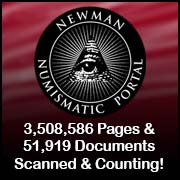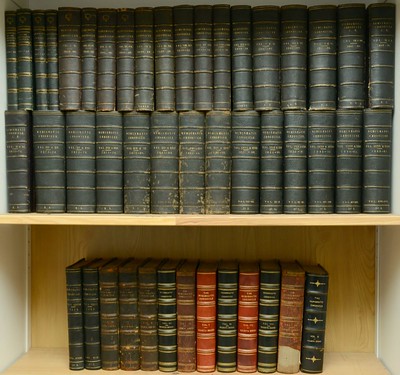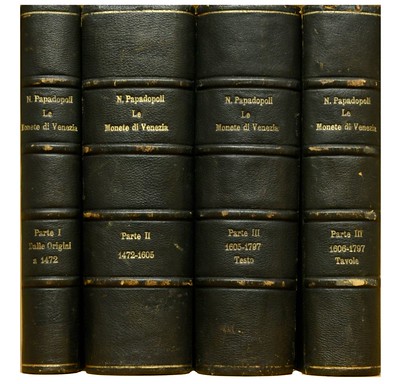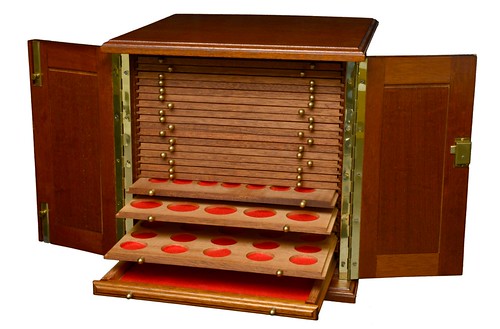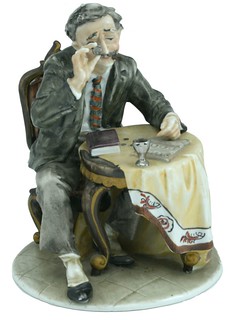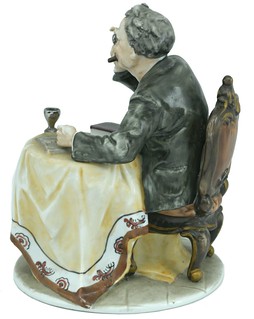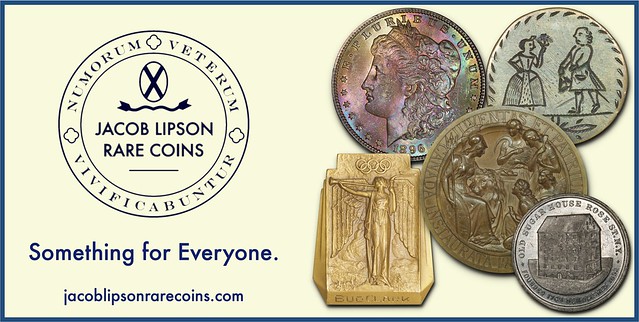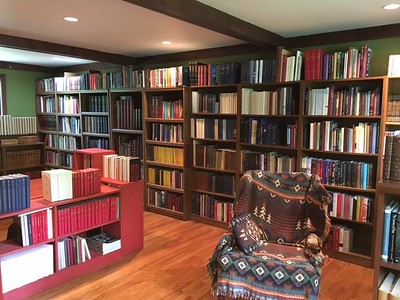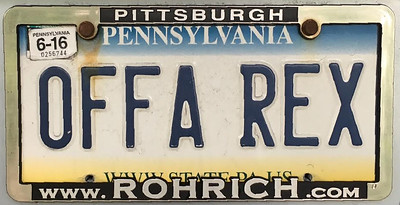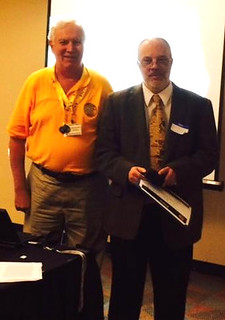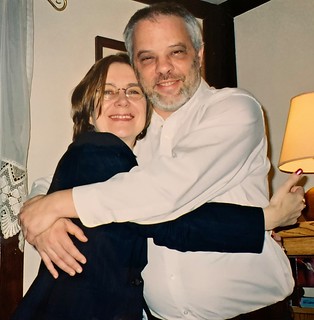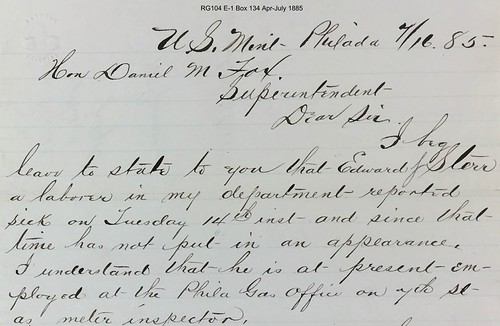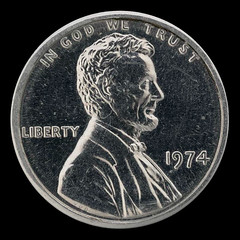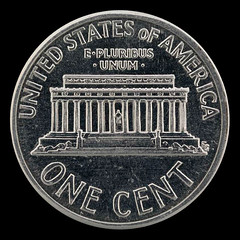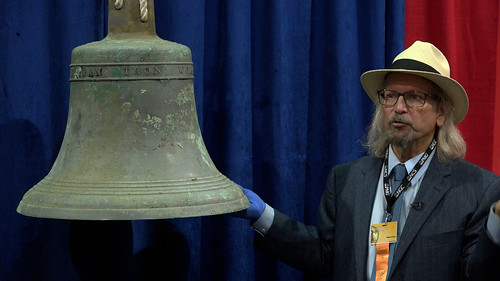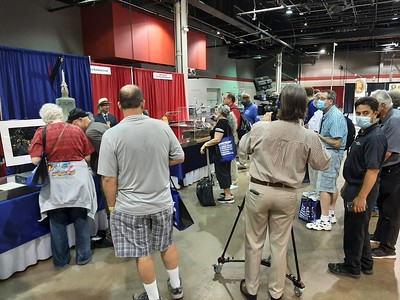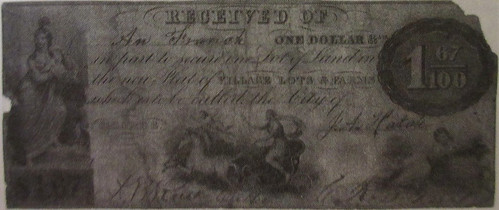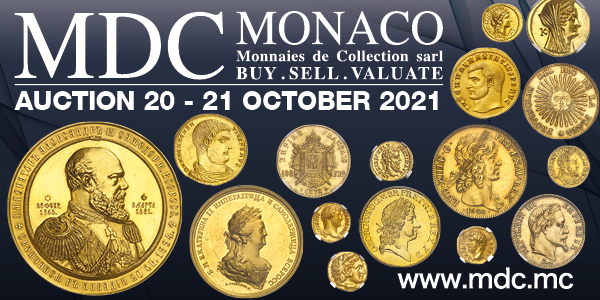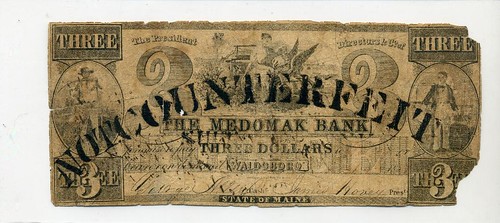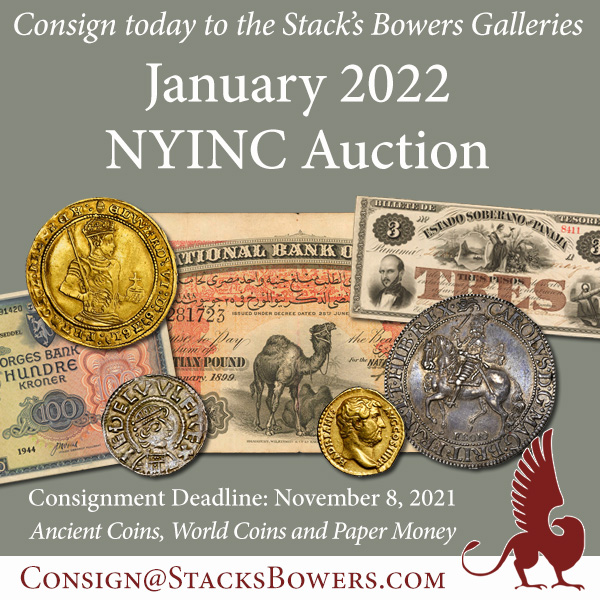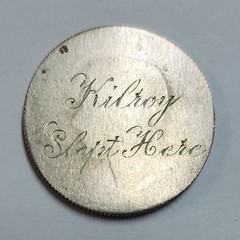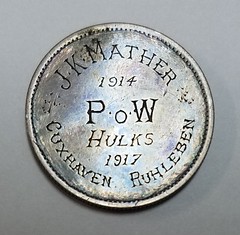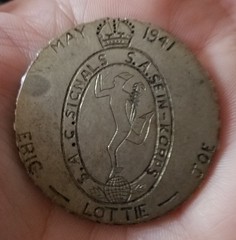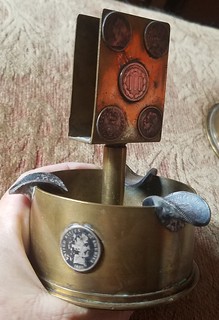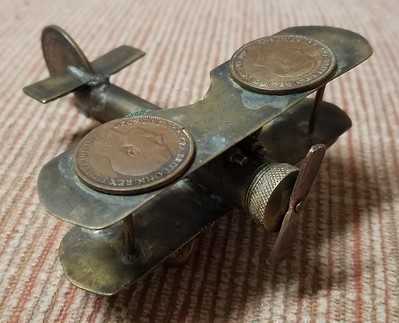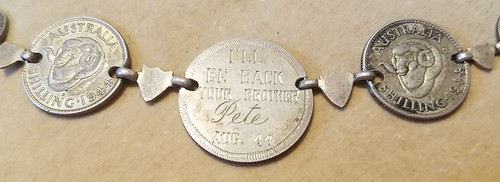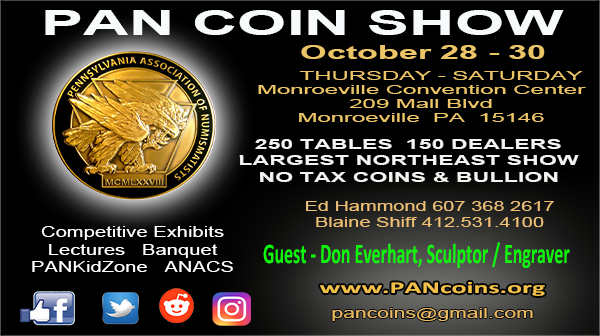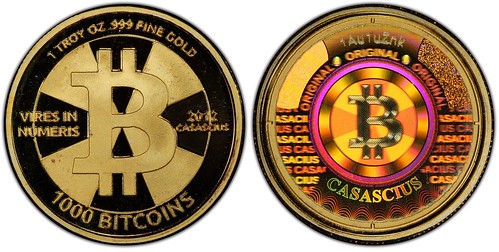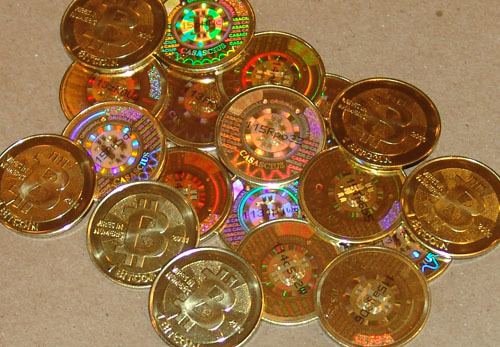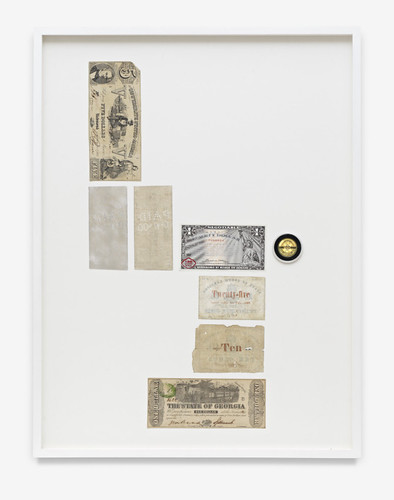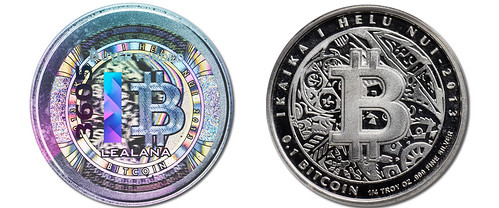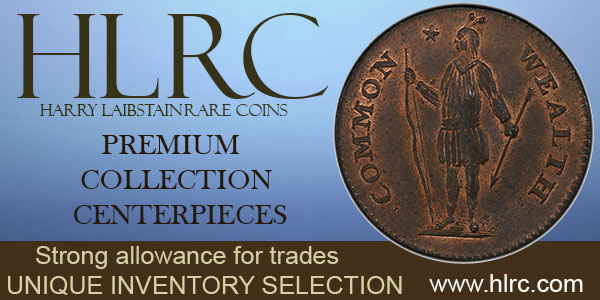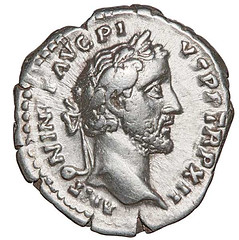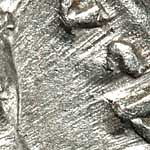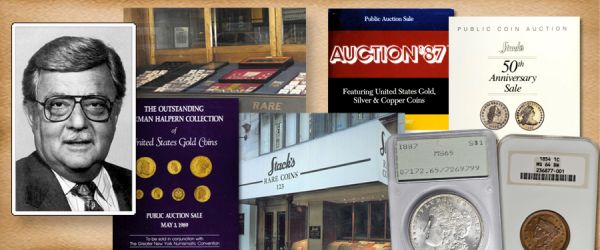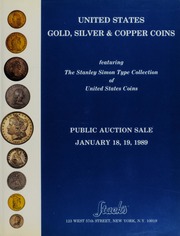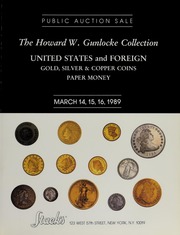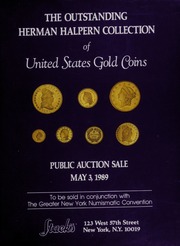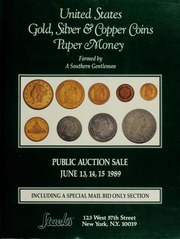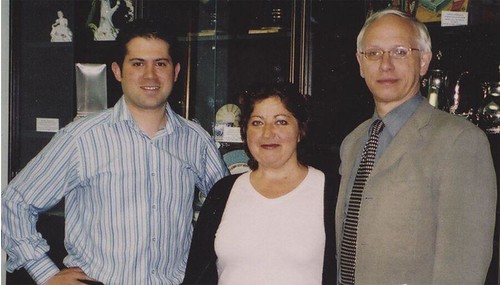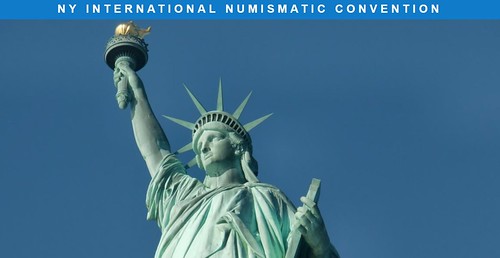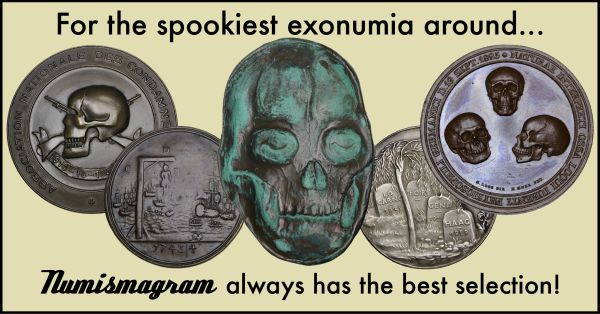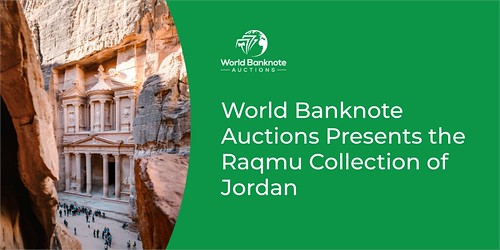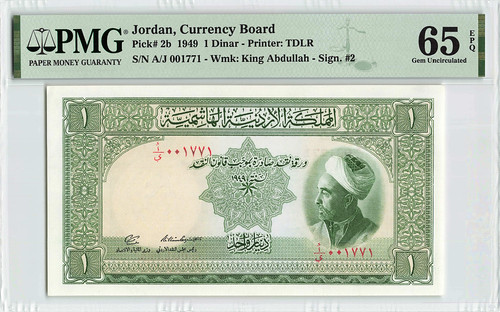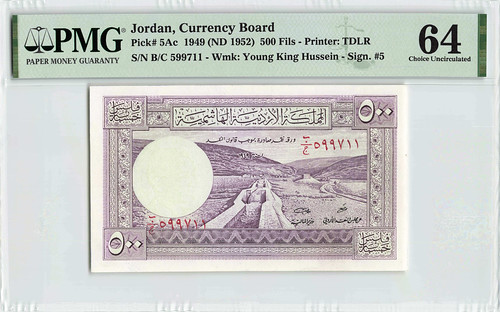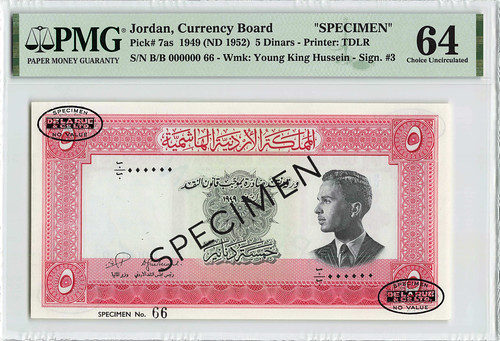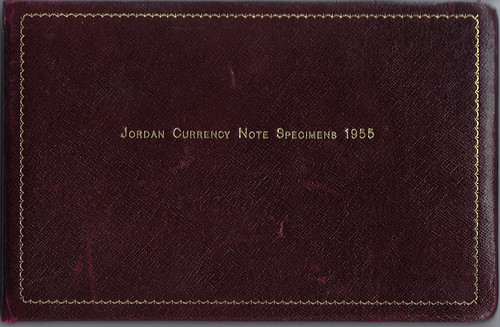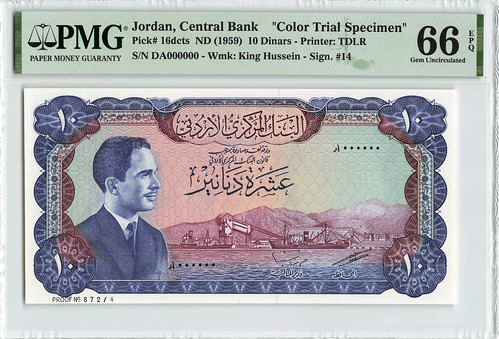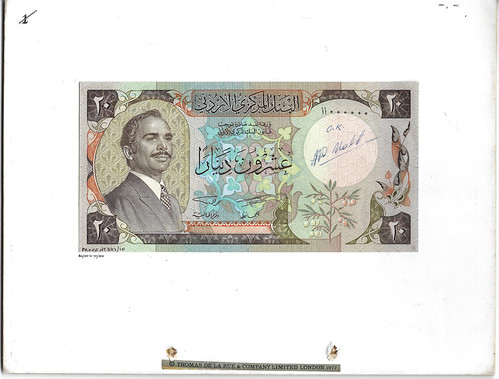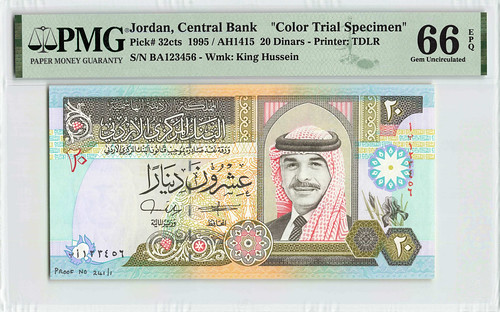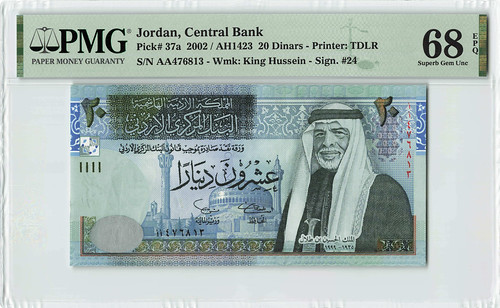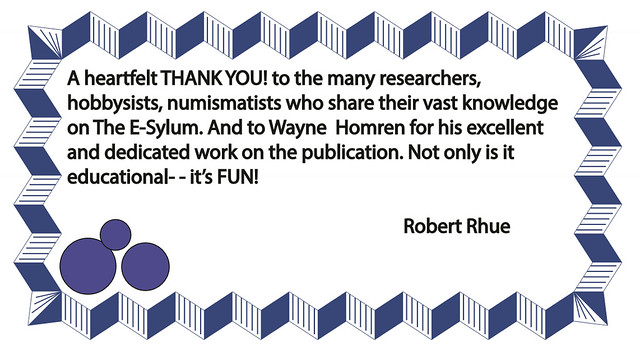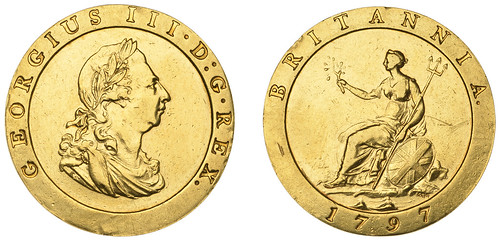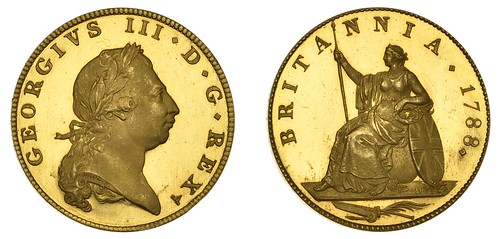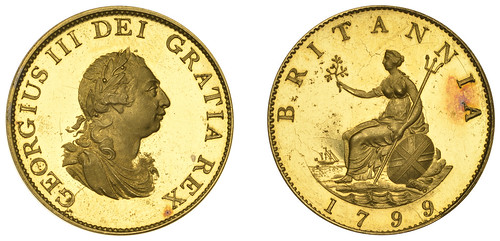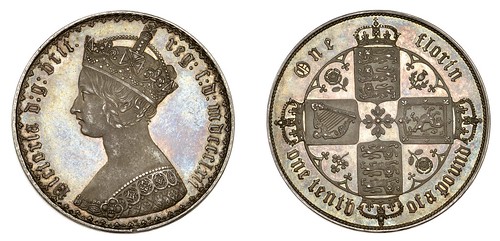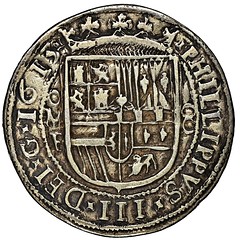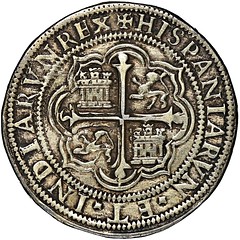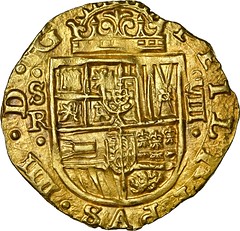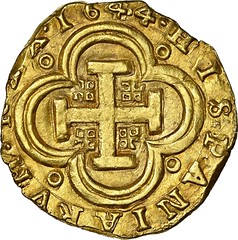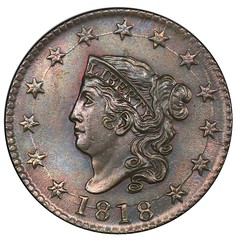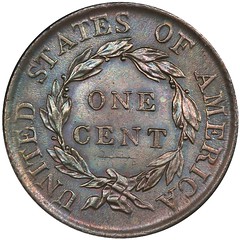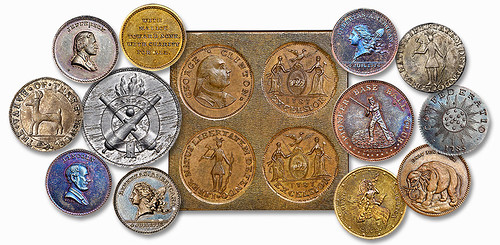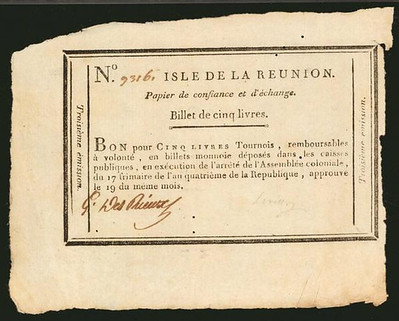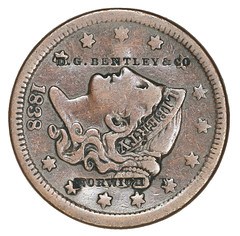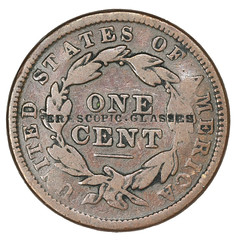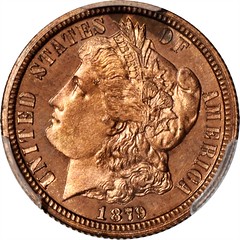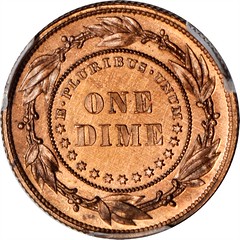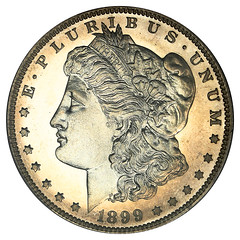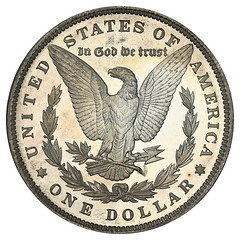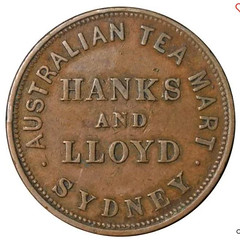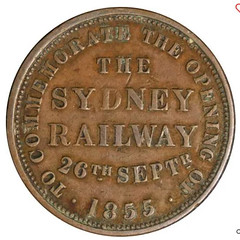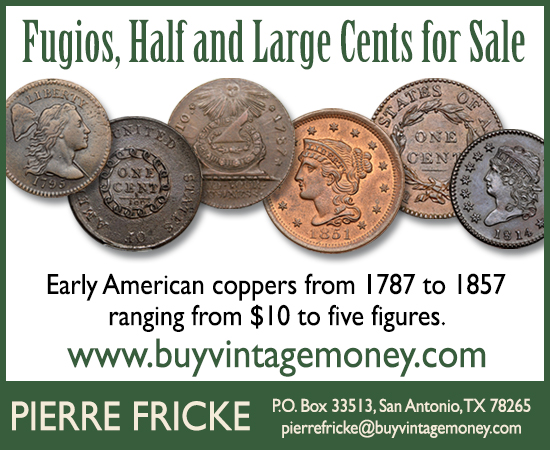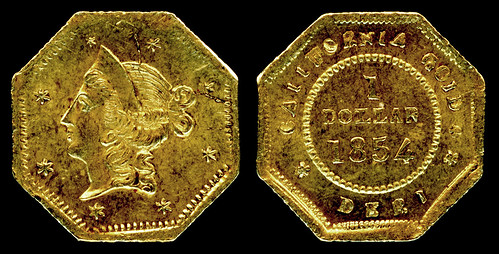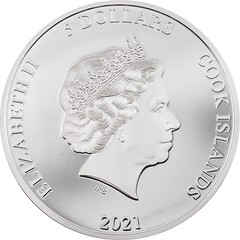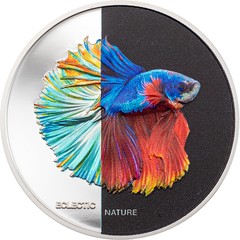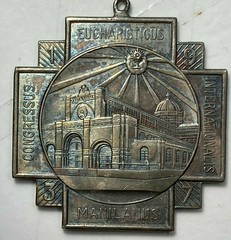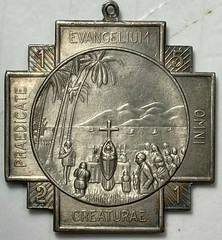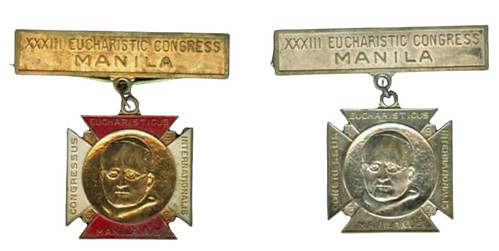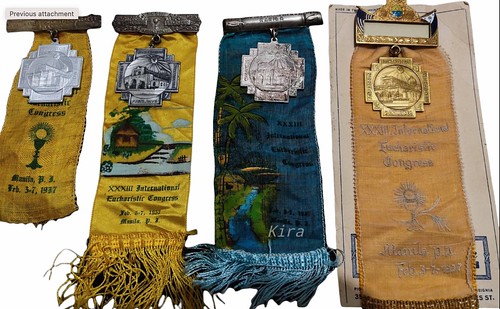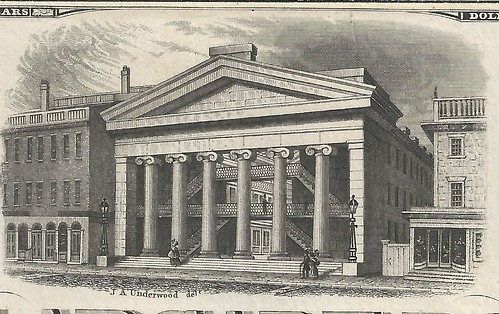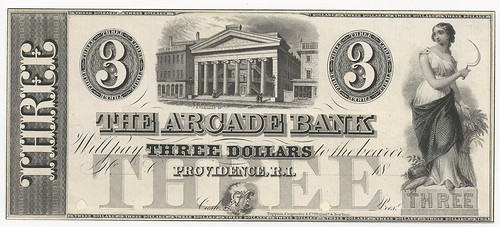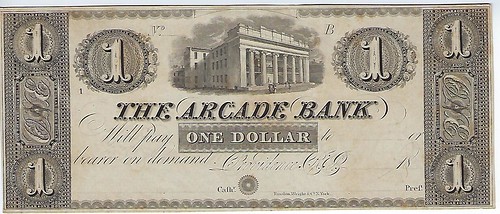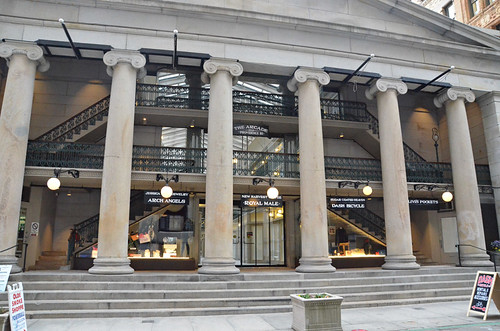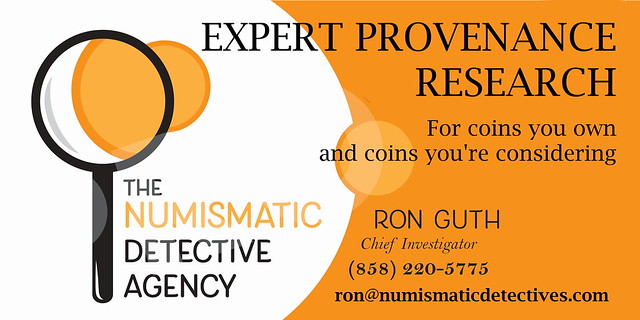
Visit our NBS Sponsors


About UsThe Numismatic Bibliomania Society is a non-profit association devoted to the study and enjoyment of numismatic literature. For more information please see our web site at coinbooks.org SubscriptionsThose wishing to become new E-Sylum subscribers (or wishing to Unsubscribe) can go to the following web page link MembershipThere is a membership application available on the web site Membership Application To join, print the application and return it with your check to the address printed on the application. Print/Digital membership is $40 to addresses in the U.S., and $60 elsewhere. A digital-only membership is available for $25. For those without web access, write to: Charles Heck, Treasurer AsylumFor Asylum mailing address changes and other membership questions, contact Chuck at this email address: treasurer@coinbooks.org SubmissionsTo submit items for publication in The E-Sylum, write to the Editor at this address: whomren@gmail.com BUY THE BOOK BEFORE THE COINSale CalendarWatch here for updates! |
- WAYNE'S WORDS: THE E-SYLUM OCTOBER 10, 2021
- DNW OCTOBER 2021 NUMISMATIC LITERATURE
- NEW BOOK: SUMPTUOUS SOUTHERN STORIES
- EDWARD TOMLINSON FORT (1961-2021)
- DALE FRIEND: A REMEMBRANCE
- NEWMAN PORTAL: MINT EMPLOYEE DOUBLE DUTY
- NEWMAN PORTAL THIRD SYMPOSIUM LINEUP
- VIDEO: SS CENTRAL AMERICA SHIP'S BELL
- THOUGHTS ON DENOMINATIONS
- NOTES FROM E-SYLUM READERS: OCTOBER 10, 2021
- WWI AND WWII COIN TRENCH ART
- 2012 GOLD CASASCIUS 1000 BITCOIN GRADED
- VOCABULARY TERM: FLOW MARKS
- HARVEY STACK'S NUMISMATIC FAMILY, PART 106
- CANADA'S OLDEST COIN DEALER
- 2022 NYINC MOVES TO NEW LOCATION
- WBNA RAQMU COLLECTION OF JORDAN SALE
- DNW IAN SAWDEN COLLECTION OF BRITISH COINS
- SEDWICK TREASURE AUCTION 30 ANNOUNCED
- STACK'S BOWERS JOHN ADAMS BOLEN MEDAL SALE
- NUMISMATIC NUGGETS: OCTOBER 10, 2021
- 2022 AMERICAN WOMEN QUARTERS DESIGNS
- NEW CALIFORNIA FRACTIONAL GOLD VARIETY
- ECLECTIC NATURE FIGHTING FISH
- 1937 MANILA EUCHARISTIC CONFERENCE MEDALS
- AMERICA'S FIRST SHOPPING MALL ON PAPER MONEY
- LOOSE CHANGE: OCTOBER 10, 2021
Click here to read the thin version on the web
Click here to subscribe
Click here to access the complete archive
To comment or submit articles, reply to whomren@gmail.com
Content presented in The E-Sylum is not necessarily researched or independently fact-checked, and views expressed do not necessarily represent those of the Numismatic Bibliomania Society.
WAYNE'S WORDS: THE E-SYLUM OCTOBER 10, 2021
 New subscribers this week include:
Brett McKinley, courtesy Larry Dziubek; and
Steve Noyes, courtesy of John Ferreri.
Welcome aboard! We now have 6,726 subscribers.
New subscribers this week include:
Brett McKinley, courtesy Larry Dziubek; and
Steve Noyes, courtesy of John Ferreri.
Welcome aboard! We now have 6,726 subscribers.
Thank you for reading The E-Sylum. If you enjoy it, please send me the email addresses of friends you think may enjoy it as well and I'll send them a subscription. Contact me at whomren@gmail.com anytime regarding your subscription, or questions, comments or suggestions about our content.
This week we open with a small literature sale, one new book, two obituaries, updates from the Newman Numismatic Portal, thoughts on denominations, and more.
Other topics this week include trench art, flow marks, the NYINC coin show, Jordan banknotes, auction previews, American Woman Quarter designs, and America's first shopping mall.
To learn more about Numismatic Chronicle, the remnants of the Confederate Treasury, the Richmond Bank trove, Tom Fort, Dale Friend, Anna May Wong, David Ryder, the 1974 aluminum Lincoln cent, the not-counterfeit banknote, the Gold Cas and Lealana physical bitcoins, Canada's oldest coin dealer, gold halfpennies, Bolen medals, Perescopic Glasses, and the $1.56-1/4 bill, read on. Have a great week, everyone!
Wayne Homren
Editor, The E-Sylum
DNW OCTOBER 2021 NUMISMATIC LITERATURE
Bibliophiles take note: there are a number of lots of numismatic literature and related material in this month's Dix Noonan Webb sales. Here are some selections. -Editor
Lot 1577: Numismatic Chronicle
Akerman, J.Y. (ed), Proceedings of the Numismatic Society, 1836-38, 1838-45, London, 439 + 117 + 43pp, bound in 2 vols, latter with 16 ALSs to John Field bound chronologically in the back, from John Williams, Francis Hobler, John Yonge Akerman, Alfred Stothard, Benjamin Nightingale, Charles Roach Smith and John Brodribb Bergne, July 1838 to January 1845; Akerman, J.Y. (ed), The Numismatic Journal, vols. I and II (1836/37, 1837/38), London, 1837-8, latter with pedigrees of Simon's Petition Crowns, 5pp, probably in the hand of J.B. Bergne, bound in the back; Akerman, J.Y. and Vaux, W.S.W. (eds), The Numismatic Chronicle, 1st [Old] series, vols. I-XX complete (1838-58), London, 1839-59, bound in 10 vols; Vaux, W.S.W., and others (eds), The Numismatic Chronicle, 2nd [New] series, vols. I-XX complete (1861-80), London, 1861-80, bound in 10 vols, vol X with 8pp ALS from C.E. Lefroy to Jonathan Rashleigh, 21 May 1888, concerning the Crondal Hoard; Evans, J, and others (eds), The Numismatic Chronicle, 3rd series, vols. I-XX complete (1881-1900), London, 1881-1900, bound in 12 vols; Evans, J, and others (eds), The Numismatic Chronicle, 4th series, vols. I-X complete (1901-10), London, 1901-10, bound in 10 vols [Lot]. All pre-1901 volumes uniformly bound in half leather and boards, ribbed and gilt spines, most of the Old series bound at the Operative Jewish Concerts' Institution, Bethnal Green; 4th series volumes with mismatched bindings and 1909 with front cover detached, contents throughout complete and very clean, some pages uncut; an exceptional set £3,000-£5,000
To read the complete lot description, see:
A superb and complete set of the Numismatic Chronicle and related publications, 1836 to 1910
(https://www.dnw.co.uk/auctions/catalogue/lot.php?auction_id=603&lot_uid=405761)
Lot 1602: Le Monete di Venezia
To read the complete lot description, see:
Papadopoli, N., Le Monete di Venezia, Venice, 1893-1919, 4 vols,
(https://www.dnw.co.uk/auctions/catalogue/lot.php?auction_id=603&lot_uid=405509)
Lot 1571: A Coin Cabinet by St Leonards
To read the complete lot description, see:
A coin cabinet by St Leonards, 33 x 33 x 32cm, comprising 24 trays
(https://www.dnw.co.uk/auctions/catalogue/lot.php?auction_id=603&lot_uid=405829)
Lot 1576: Porcelain Coin Collector Figure
To read the complete lot description, see:
A porcelain figure of a coin collector, man seated at small table
(https://www.dnw.co.uk/auctions/catalogue/lot.php?auction_id=603&lot_uid=406467)
For more lots, see:
Numismatic Books from Various Properties (45 lots)
(https://www.dnw.co.uk/auctions/catalogue/results.php?auction_id=603&heading_id=4445)
Coin Cabinets and Ephemera (6 lots)
(https://www.dnw.co.uk/auctions/catalogue/results.php?auction_id=603&heading_id=4452)
NEW BOOK: SUMPTUOUS SOUTHERN STORIES
Becky Rush "Talisman" and Rick Lank "The Coiner" of Hagerstown Maryland have published the third book in their planned series on the numismatics of the U.S. Civil War. Here's the announcement. Thanks! -Editor
Sumptuous Southern Stories of Missing Confederate Money
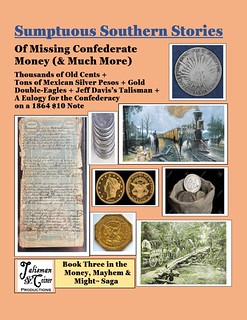 Racing against time – and doubling-down on their odds of escaping the pursuing
federal cavalry – the
Racing against time – and doubling-down on their odds of escaping the pursuing
federal cavalry – the Confederate Treasure Train
raced south from Richmond
until it literally ran out of track and options in a north-eastern Georgia town called
Washington. On board this ill-fated train (which ultimately had to resort to
becoming an unwieldy wagon train) was money – a strange brew of northern gold
coins, Mexican silver coins, slugs
of Georgia and Carolinian gold sweepings,
and bales of Confederate (CSA) paper currency. There were also barrels of
copper coins,
probably old US large cents (obsolete, but still valuable).
There was plenty of cunning and internal deal-making, as well as good and bad
intentions afoot, as the last days of the Confederacy played out and the money that
was left in the CSA Treasury was hurriedly put on board steam trains that dashed
south out of Richmond, Virginia when the Queen City
fell to Union forces led by
U.S. Grant. Wealth of every description was part of the exodus – the remnants of
the Confederate Treasury, the gold (and other private treasure) of the principal
Richmond banks and unlisted stores of money from wealthy individuals (which no
doubt could have included the infamous and influential Knights of the Golden
Circle – KGC). Private wealth included in this mix of coins were every
denomination from $50 hexagonal gold pieces to older small change,
including
half-dimes struck in New Orleans.
Official and court records also show that abundant Richmond Bank gold was
funneled on board – about 7 million dollars' worth in today's spending power – all
intended for Confederate General Robert E Lee's bedraggled Army of Northern
Virginia. Controversy existed regarding whether or not the Bank Money
was
subject to the Union's Confiscation Laws; this issue was debated in federal court
for 28 years.
All along the route that the money took -- from Danville, VA to Greensboro and
Charlotte, NC and through Newberry, Abbeville and Vienna, SC and finally
several stops in Georgia – the troubles multiplied (Lincoln was assassinated;
Generals Lee and Johnston surrendered, and the Union forces closed in). The
money on that beleaguered train– especially gold and silver – became the envy of
pardoned Confederate soldiers as well as the Union cavalry.
Sumptuous Southern Stories of Missing Confederate Money is a fine spread of these tales of coins and currency, mishaps and mayhem, and a big dash of adventure that traces the path of the Confederate Treasure Train to its end and beyond. The events took place in April and May of 1865 – and they involve barrels of silver coins possibly being left in a cemetery in Danville, VA plus $50 California gold pieces being heisted near Petersburg, GA and $25,000-plus of British Gold Sovereigns being secretly disbursed near rural Gainesville, FL.
Our earlier book – The Furious Flight of the Confederate Treasure
Train – or – Where Did All the Southern Dough Go?
-- delved into
this story of the very end of the Civil War. This first book examined many of the
personalities involved and towns that were traveled through as the steam trains
yielded to wagon-trains and traveled through areas along the Savannah River that
are now under 30 feet of water.
The authors – Talisman & Coiner
– traveled through the South on a Dixie
Dive
in June of this year – and uncovered yet more stories and lore, which gave
rise to Sumptuous Southern Stories...
And, more stories are drifting in to us!
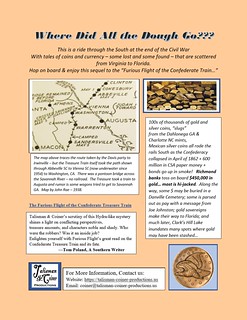 This sequel picks up on intriguing stories of missing money and maneuvers to
escape capture and ransacking, including more insights into the heist of the
Richmond Bank
This sequel picks up on intriguing stories of missing money and maneuvers to
escape capture and ransacking, including more insights into the heist of the
Richmond Bank trove
and honor among thieves
as revealed by one of
Vaughn's Brigade's former cavalrymen when he was in his 70s. And there is an
intriguing investigation into a massive iron strongbox that has been sitting quietly
in a Georgia library for a century that was opened with fanfare in 1948 – we'll
reveal what was found (or not). And then there is the hand-written Eulogy
to the
Confederacy that was originally written on the back of a CSA $500 bill in a hotel
in Richmond by a paroled soldier who had served under General Johnston & was
copied over and over by veterans as a memento to the Lost Cause.
(Talisman &
Coiner have the good fortune of having seen such a Confederate bill – this time, on
a $10 note – thanks to Erick Windsor, avid coin dealer.) And David Hill of the
American Numismatic Society (ANS) was kind enough to share a rare Davis
Capture Shield
– dated May 10th 1865 – and hand-struck on a Mexican Reale.
The book is 8 1/2 by 11 inches and has nine chapters with fewer than 100 pages. It is spiral-bound for easy reading and sharing with friends and family. There are ample color and black-and-white photos and illustrations through-out,
Bulk orders for coin clubs and school groups are available.
Here's the table of contents. -Editor
- Acknowledgements
- Introduction
- Chapter One -- Danville and the Silver Cemetery
- Chapter Two -- Joe Johnston and the 39,000 mementos
- Chapter Three -- The Randall Hoard Connection (perhaps) & the Georgia Railroad & Banking Co. scrip and legend
- Chapter Four --- The Clark's Hill Dam and 75,000 acres go Underwater – many spots where the Treasure Train traveled & Treasure was pitched
-
Chapter Five – Where Did All the Dough Go? 5 Stories
Oceans of it (gold that is!)
andIn the Heels of their Boots!
-
Chapter Six – INSIDE JOB? (Or who snagged the Swag?)
The Story of the Ones who got away! Told by Judge
Shepherd in 1914 (
Honor Among Thieves
) - Chapter Seven – The Mystery of the Confederate Treasure Chest
-
Chapter Eight – The Jefferson Davis Talisman (his 50 cent
piece) and the
The Shield Flight Medal
struck from a Mexican Silver Coin -
Chapter Nine –
Eulogy
orNote on a CSA Ten Dollar Bill
For more information, or to order, see:
https://talisman-coiner-productions.us/
The authors can be reached by email at coiner@talisman-coiner-productions.us . -Editor
To read the earlier E-Sylum articles, see:
NEW BOOK: MONEY, MAYHEM AND MIGHT
(https://www.coinbooks.org/v22/esylum_v22n34a06.html)
NEW BOOK: THE CONFEDERATE TREASURE TRAIN
(https://www.coinbooks.org/v23/esylum_v23n46a04.html)
NEW BOOK: MINTING PRINTING & COUNTERFEITING
(https://www.coinbooks.org/v24/esylum_v24n21a03.html)
EDWARD TOMLINSON FORT (1961-2021)
I was quite saddened this week to learn of the sudden passing of my good friend Tom Fort - numismatic researcher, bibliophile, and former editor of our print journal, The Asylum. American Numismatic Biographies author Pete Smith pulled together this bio and remembrance. Tom's wife Gosia supplied Tom's photo. -Editor
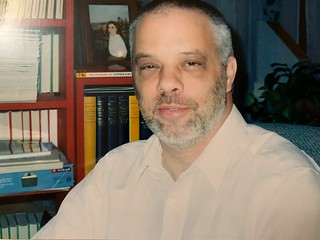 Tom Fort was born on September 14. 1961, the son of James Tomlinson Fort and Judith A.
Davis. James was an attorney and senior partner with the Pittsburgh law firm of Reed Smith
Shaw and McClay for more than fifty years.
Tom Fort was born on September 14. 1961, the son of James Tomlinson Fort and Judith A.
Davis. James was an attorney and senior partner with the Pittsburgh law firm of Reed Smith
Shaw and McClay for more than fifty years.
Tom attended Penn State University 1980 to 1985 and received a B.A. in European History. He went to Scotland and University of St. Andrews during 1985-1987 where he earned a Master's degree in Medieval History and Numismatics. Later at St. Andrews he was a tutor in Medieval History 1988 to 1990.
Returning to Penn State University at New Kensington, he was an adjunct Associate Professor in ancient and medieval history 1990 to 1995. He was also an Adjunct Associate Professor at La Roche College in Pittsburgh 1993 to 1995. In 1995, Tom married Malgorzata Mozer (Gosia), of Polish ancestry. She has a Doctor of Humanities degree and manages rare book preservation and special collections at the University of Pittsburgh. They have a daughter Annamaria.
Temporarily out of school, Tom worked as assistant editor for The AAA Motorist, a publication of the American Automobile Association, East Central, 1995 to 2001.
I wish I could date my first contact with Tom Fort. At one time the Pennsylvania Association of Numismatists offered a travel grant for research related to Pennsylvania numismatics. I was researching the Eckfeldt family and submitted an application. A letter of acknowledgement came back from Tom Fort. I did not receive the grant.
Tom was recruited to be editor of The Asylum, the journal of the Numismatic Bibliomania Society, starting in October, 1999. After I became president of NBS, he would send me an advance copy of the newsletter, I would review it, and we would talk about it on the phone. Of all my duties as president, managing publication of the newsletter took the most time. Tom promoted and edited the massive twenty-fifth anniversary edition of The Asylum in Summer 2004 (Vol. XXII, No. 3). When Tom resigned after two issues in 2006, we found a replacement in David Yoon as of the January 2007 issue.
Tom and Wayne Homren organized The Great Numismatic Libraries of Pittsburgh Tour on
Friday, August 20, 2004. Tom's contribution was The E. Tomlinson Fort Memorial
Library
with his specialty on ancient and medieval numismatics. Off to one side was the Doc Savage
annex. Twenty-Four people who attended were listed in The Asylum. (Vol. XXII, No, 4) page
369.
Relieved of the duties as editor, Tom did post graduate studies in European History and Roman Culture at the University of Pittsburgh 2007 to 2009.
Tom's list of memberships includes the British Numismatic Society, the Royal Numismatic Society, Société Française de Numismatique and he was a fellow of the American Numismatic Society. His local memberships include the Western Pennsylvania Numismatic Society and the Pennsylvania Association of Numismatists. Tom had several scholarly articles published on his specialties of ancient and medieval numismatics. Outside of Numismatics, he was a benefactor of the US Chess Federation.
Tom was troubled with health problems in recent years and died on October 5, 2021.
I've also known Tom so long that I've forgotten where we first met. It was likely a local meeting of the Pittsburgh Numismatic Society or the Pennsylvania Association of Numismatists. Two collectors meeting at a coin club is no big coincidence. But what are the odds of this? - before long I learned he had an apartment in the same suburban building as my then-girlfriend, and a few years later we found ourselves living on the same city street. As Tom delighted in pointing out, there were two major numismatic libraries within a couple blocks walk of each other, and there were probably only a dozen titles in common between them. Tom's specialty was medieval coinage, and my interests were mainly American.
Here's a photo of his library in the home purchased after marrying Gosia. This was one of the stops of the 2004 event. I always told Tom he was my numismatic bibliophile hero - he married a librarian! -Editor
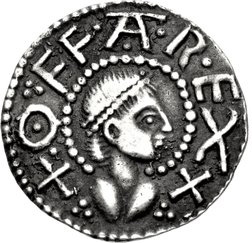 Tom's favorite medieval ruler was King Offa, hence his catchy license plate.
Tom's favorite medieval ruler was King Offa, hence his catchy license plate.
Tom was a natural Anglophile and returned to visit London and Scotland whenever a trip could be arranged. Spending a number of months in London in 2007 turned me into an Anglophile as well. While I never picked up the medieval coin collecting bug, that was one more thing we had in common.
Such a shame to lose him so early. I'd been looking forward to seeing him on my planned trip to Pittsburgh this month. Rest in Peace, Tom. Continue your researches in the library of Heaven, and give our regards to your old friend Offa. -Editor
Larry Korchnak writes:
"Tom's background in history and interest in coins made him the consummate numismatist. It was no surprise to me that he was drawn to books given his inquisitive nature. Tom was always eager to share his knowledge by presenting at local coin club meetings and enlightening the members with his newest volume or medieval coin acquisition. His quick wit was engaging and he never lost his sense of humor even as he endured numerous medical procedures. The hobby has lost a true gentleman and scholar; I lost a friend."
Douglas Saville writes:
"I was really saddened to hear of the passing of Tom Fort. I regarded Tom as a good long-standing friend. When he was based at St Andrews in the mid 1980s he would often travel to London and visit me in Spinks-and buy a book or two. He was always enthusiastic about his studies in St Andrews. He was enthusiastic about everything actually. He stayed there until the early 1990s tutoring in Medieval History.
In all things he was so positive that I was almost in awe at how he could be that way. He had numerous long-standing health issues. After he settled back in Pittsburgh he would often call me with updates on what he was doing, His family, Gosia and his daughter - he was proud of both.
He had planned a trip to Scotland just before lockdown- so that was cancelled but he re-planned it for this year but ill health stopped that- but he was looking forward to the trip next year- visiting old haunts in Scotland and a trip or two to London, Oxford and to me in Reading. I am really sad that it won't happen now."
David Fanning writes:
"I was shocked to learn of Tom Fort's death this week, as I had just visited him five or six weeks ago. While I was aware of his various health problems, he seemed his usual self and it was good to see him and catch up on things. I always admired his meticulously arranged library—or, I should say, libraries, as his comic library was nearly as extensive as his numismatic library. The neatness of his shelves and their pleasing organization always made me cringe a bit when thinking of the relative chaos of my own.
I probably met Tom in 2000 at a PAN show. He served as the Editor of The Asylum from 1999 to 2006, and I joined him as Editor in Chief in 2001, working with him for the next five years. Together, we produced the Summer 2004 special book-length issue published for the NBS's 25th anniversary, though as I was bogged down compiling my bibliography of Breen included within, I suspect most of the actual work fell to Tom. He was always energetic and brought a keen intelligence to everything he did. He will be missed by many, and my heart goes out to Gosia and Annamaria."
LEFT: Rich Jewell supplied this photo of him and Tom (at right in suit and tie) at the October 2015 Pennsylvania Association of Numismatists show.
RIGHT: Gosia published this great photo of her and Tom on Facebook.
Thanks, everyone. Douglas is quite right about Tom's upbeat attitude. His ready laugh and sense of humor were his signature, equally at home joking over the foibles of medieval royals, the nuances of pulp comics and their creators, or the hammy acting and plot trivia of Star Trek. He will be greatly missed. -Editor
DALE FRIEND: A REMEMBRANCE
Last week Doug Winter published this blog remembrance of collector Dale Friend. -Editor
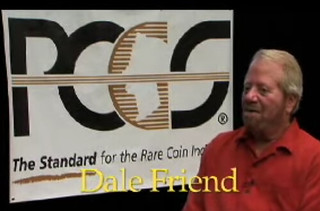 The first time I can recall interacting with Dale Friend was around 15 years or so ago. I was setting-up at a coin show, and he came up to my table asking to see a Proof 1864 gold dollar that I owned. He introduced himself and told me that he was working on assembling a complete 1864 Proof gold set (a challenge which seems impossible today!) and that he needed just the gold dollar to be complete. I remember laughing and telling him,
The first time I can recall interacting with Dale Friend was around 15 years or so ago. I was setting-up at a coin show, and he came up to my table asking to see a Proof 1864 gold dollar that I owned. He introduced himself and told me that he was working on assembling a complete 1864 Proof gold set (a challenge which seems impossible today!) and that he needed just the gold dollar to be complete. I remember laughing and telling him, I'd have thought the gold dollar would have been the first coin you bought for the set not the last coin.
There was one caveat: the coin I owned was in an NGC holder and Dale would only buy PCGS graded coins. I told him this wasn't a problem and that I would try and cross the coin for him. I submitted the coin to PCGS and 24 hours later, I had it back; I now in a PCGS holder. I paged Dale to the table and showed him the coin. Dale asked me the price and I told him I would honor what I quoted him when the coin was in its original holder, even though I could have easily raised the price by $2,500. He wrote me a check and went away happy. In fact, in every deal I did with Dale, we both went away happy.
Dale was a man of his word and a collector's collector; one of the few I have met who really understood the dynamics of the coin market and who appreciated choice, original coins; especially Barber and Bust half dollars and early silver dollars. Dale was more of a dabbler when it came to gold coins, but he did have a nice collection of early half eagles at one time with many of the coins graded MS63 and MS64.
Dale was best known for his outstanding sets of Liberty Nickels, Barber half dollars, and Bust half dollars. His Barber half dollar set was started in 1992 and if I remember correctly, it was his first serious collection as an adult. His star coin was the awesome PCGS MS68 1892-O Micro O from the Eliasberg and Clapp collections, which is universally regarded as the single best Barber half dollar in existence. As he became a more sophisticated collector, he began collecting Bust half dollars and dollars by Redbook variety. All of these sets were exceptional and some of Dale's halves were sold at the 2018 ANA auction by Heritage. If I'm not mistaken, his lovely set of Bust Dollars remains intact.
Dale had a very good eye when it came to silver coinage. I always would kid him about his coins having The Dale Friend Look
which was a toning pattern where the centers were lighter than the borders and the deeper toned areas were boldly iridescent. Coins kept in certain old storage albums sometimes come with this appearance, but it is really hard to find many early half dollars/dollars with a DFL appearance. Funny story: to this day, I still mark a coin DFL (for Dale Friend Look) in an auction catalog when I am viewing lots.
I always enjoyed talking coins with Dale. He was passionate and opinionated. If you were a dealer and you screwed Dale on a coin, you were placed on his Bad List but if you treated him well, he was loyal and generous. Dale vouched for me with a collector-acquaintance of his who didn't know me and I wound up representing him as his agent for well over $1,000,000 of coins at the first three Pogue sales. Dale didn't have to do that, and I was truly touched by his support.
Dale and his wife Stacy were really fun to be around. They truly loved each other and when my wife Irma and I were at shows with the Friends, good conversation and plenty of laughs were always involved.
I last spoke to Dale a few weeks ago. He was recovering from major heart surgery but he sounded great and told me he would see us soon. He also wanted to share that a Barber half dollar that I purchased for him at the Larry Miller collection sale earlier in 2021 had crossed from NGC66 to PCGS66 (as I had said it would), and that he was grateful for my advice.
Dale, I'll miss you a ton. You were a great friend and you meant a lot to me, and to many others.
To read the complete article, see:
Dale Friend: A Rememberance
(https://raregoldcoins.com/blog/2021/10/2/dale-friend-a-rememberance)
NEWMAN PORTAL: MINT EMPLOYEE DOUBLE DUTY
The latest addition to the Newman Numismatic Portal is correspondence relating to the firing of a Mint employee. Project Coordinator Len Augsburger provided the following report. -Editor
Mint Employee Does Double Duty
With the explosion in remote work, there have been occasional reports of individuals holding two jobs simultaneously, unbeknownst to their employers. A similar situation appears to have taken place in the U.S. Mint in 1885. Chief Engineer John L. McGinnis wrote to the Philadelphia Mint Superintendent Daniel M. Fox on July 16, relating that one Edward J. Sterr, laborer, had reported sick to the Mint, while being seen working as a meter inspector at the Philadelphia Gas Office. Fox summarily fired Sterr, by mail, the same day, and a response from Sterr is recorded the following day, noting that he had resigned.
Sterr is not listed in the 1883 or 1885 Official Register and seems to not have been a Mint employee of longstanding.
Image: extract from July 16, 1885 correspondence from McGinnis to Fox
Link to Official Register of the United States on Newman Portal:
https://nnp.wustl.edu/library/publisherdetail/536877?Year=1885&displayAmt=50
Link to July 16, 1885 correspondence from McGinnis to Fox
https://archive.org/details/employeeabsentbutseenatotherjob18850716/page/n1/mode/2up
NEWMAN PORTAL THIRD SYMPOSIUM LINEUP
Launched in August 2020, the Newman Numismatic Portal (NNP) Symposium brings together a diverse selection of numismatic presentations into a concentrated, three-day, Zoom-based format. The third NNP Symposium takes place later this month. Len Augsburger provided the following report. -Editor
Newman Portal Symposium Takes Place October 15-17, 2021
The Newman Numismatic Portal Symposium is back with another group of presentations over the weekend of October 15-17. This is our third such event. The full schedule is now online, and we'd like to call special attention to our session on the National Numismatic Collection (NNC), which takes place at 11:30am eastern time on Friday, October 15. We'll be premiering a video focusing on the U.S. coins in the NNC, and Curator Ellen Feingold and Museum Specialist Jennifer Gloede will be on hand to answer audience questions following the video presentation. More and more of the national coin collection
is coming online, allowing collectors and researchers virtual access to this all-important cabinet built over the last two hundred years. This will be an excellent opportunity to learn more about the NNC and ask questions directly of the curators.
Image: 1974 aluminum Lincoln cent from the National Numismatic Collection
Link to Newman Numismatic Portal Symposium schedule .
THE BOOK BAZARRE
VIDEO: SS CENTRAL AMERICA SHIP'S BELL
These are selections from the David Lisot Video Library that feature news and personalities from the world of coin collecting. David has been attending coin conventions since 1972 and began videotaping in 1985. The Newman Numismatic Portal now lists all David's videos on their website at:
https://nnp.wustl.edu/library/multimediadetail/522852
Here's one on the tolling of the SS Central America Ship's bell at the 2021 ANA World's Fair of Money. -Editor
SS Central America Ship's Bell Tolls at American Numismatic Association Convention 2021.
VIDEO: 10:04.
Robert Evans, Chief Scientist, SS Central America,
David Lisot, Producer, CoinTelevision.com.
August 10-14, 2021.
The bell from legendary Ship of Gold
, the SS Central America, was on display at the World's Fair of Money in Chicago. Recovered during salvage efforts the bell helped identify the shipwreck. Expedition chief scientist Robert Evans discusses the significance of the recovery and tolls the bell for viewers.
An excerpt of the video is available for viewing on the Coin Television YouTube Channel at:
https://youtu.be/sk-7oseUKs4
Check out the video - it's impressive. What a fantastic artifact! I watched as David filmed the event. Here's a photo from my ANA diary article. -Editor
To read the earlier E-Sylum article, see:
WAYNE'S AUGUST 2021 ANA DIARY, PART TWO
(https://www.coinbooks.org/v24/esylum_v24n34a21.html)
THOUGHTS ON DENOMINATIONS
A $25 Harriet Tubman banknote design by Wayne Pearson led to my earlier question "Why do we have a $20 bill and a 25-cent piece, anyway?" John Phipps submitted a response last week. Here are some reader comments. -Editor
Wayne Pearson writes:
"I've considered the Tubman $200. I would like it because it would be a larger bill. And I'm not opposed to that denomination over the $25. I agree that we want the least amount of units of money in change. I don't think the $25 messes this up.
"$99 is the most we can get in change. Providing we use the $2 bill-currently $99 would be (1) $50 (2) $20's (1) $5 and (2) $2's total of (6) bills With a $25 in the you would have (1) $50 (1) $25 (1) $20 and (2) $2's for a total of (5) bills. I think the idea could be smoothly worked into the existing family of seven. I had a $15 dollar bill idea because when you get change of a $20, if you spend less than a dollar you use a $5 a $10 and 4 $1's since we don't use the $2. And anything above $15 in change uses a lot of fives and tens. The idea was to make both denominations last longer. But 15 doesn't go into 100 evenly so I scrapped the idea."
Here's what Martin Purdy wrote. -Editor
"So, we have 1/2 dollars, 1/2 dimes and 1/2 cents. Splitting the halves in half again and we have 1/4 dollars. Historically we have split these in half again and gotten pieces-of-eight. We have other fractions of a dollar. One tenth of a dollar is not called a tenth it is called a dime. One hundredth of a dollar is not called a hundredth it is called a cent. This is because splitting into 10 or 100 equal pieces is harder for the human mind to consider. So why do we have a 25-cent piece? The answer is culture."
That's a very strange argument, and I'm sure I won't be alone in pointing out that "dime" owes its origins to "dixième" in French or its Latin ancestor, meaning precisely "tenth", and "cent" from "centième" or hundredth. Different languages, same terms. As for tens and hundreds being hard, why do we do math in base 10 rather than base 8 or base 16?
I can understand the historical logic of carrying over quarters of cut Spanish dollars into modern usage, and that's probably the only explanation needed for the 25c piece. A quick look around Europe shows the situation isn't so cut-and-dried. Prior to the Euro, Holland had a 25-cent piece (and Belgium 25 centimes), but East Germany 20 pfennigs, Italy 20 centesimi and France 20 centimes (though the latter also had "quarters" at various times) - and Russia did its own thing with 1, 2, 3, 5, 10, 15, 20 and 50 kopeks!
Even dollar currencies closer to the US don't all follow the US pattern - 15 and 25 cents in the Bahamas, both 20 and 25 cents in Jamaica, and the independent territories throughout the Pacific have 20s rather than quarters ... is it really anything more than just local habit?
Vic Agha added these thoughts about denominations. -Editor
Want a few thoughts on that 25c and $20 issue? I noticed it some time ago and was thinking of a logical reason why it might be true. The answer is, our dollar system is based on 1s, 10s, and later 100s, and other denominations are found by halving those numbers. Half of $1 is the half dollar, half of that is a quarter dollar, etc.
Here's the thing: originally, our coinage system only went to $10. We got a $20 coin in 1849 because instead of halving/quartering a $100 denomination, we doubled the $10 denomination. Paper bills came a few years later, and at that point we may as well stick with the $20 I suppose.
I am aware that earlier, private issues included $20 and $100 denominations, but those were private issues to begin with and people did all sorts of weird things back then (though often a reason was to be had). Are you familiar with the $1.67 bill (1 known) from Michigan, or the $1.56-1/4 bill (none known) from Philadelphia?
Odd denominations are seen frequently in U.S. tokens and obsolete paper money. Here are some additional notes from Vic. -Editor
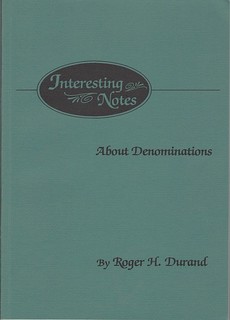 In 1988, Roger Durand published a book called Interesting Notes About Denominations, listing all the unusual denominations he found on currencies. There are no images of the bit-denominated notes, like $1.37-1/2, $1.56-1/4, $1.87-1/2, etc because none are known to survive. I mean, there are a few 18-3/4c notes of course...
In 1988, Roger Durand published a book called Interesting Notes About Denominations, listing all the unusual denominations he found on currencies. There are no images of the bit-denominated notes, like $1.37-1/2, $1.56-1/4, $1.87-1/2, etc because none are known to survive. I mean, there are a few 18-3/4c notes of course...
Now if you go further into this, like privately-issued scrip, you get other interesting results that Durand did not note. For example, the Liverpool NY depression scrip has face values of 50c cash/52c trade and $1 cash/$1.05 trade.
If you go into tokens, you of course get even more unusual denominations, something people don't even think about if they just stick to American coins. I know in the past you've brought up the Awensdaw $1.10 token before. I know a lot about denominations because I just published my research into these in the October and November issues of Talkin' Tokens (NTCA publication).
Thanks, everyone. That $1.56-1/4 one is quite strange. But Dave Schenkman noted "It is, unless you look at it as 25 bits..." I had to pull out my (cellphone) calculator to confirm that, but he's right. Wow! The world sometimes makes sense when viewed thru numismatic-colored lenses.
The denomination is recorded in Durand's book as "No specimen recorded... According to Wismer's research, [The Philadelphia Bank] issued a note of the $1.56-1/4 denomination. This represented 1/10 of Spanish doubloon. $31,250 of this denomination were issued and all were redeemed and destroyed in 1817 or in that time period." I did the math with my handy calculator, and that implies an issue of 20,000 notes. -Editor
To read the earlier E-Sylum articles, see:
PEARSON: MORE DESIGNS FOR U.S. PAPER MONEY
(https://www.coinbooks.org/v24/esylum_v24n39a14.html)
WHY DO WE HAVE A $20 BILL AND A 25 CENT COIN?
(https://www.coinbooks.org/v24/esylum_v24n40a12.html)
NOTES FROM E-SYLUM READERS: OCTOBER 10, 2021
On Changing the World of Numismatics
Regarding my recent interview in The Centinel,
former American Numismatic Association Executive Director
Bob Leuver writes:
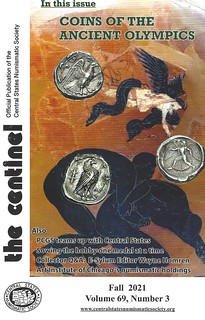 "I very much enjoyed the article. You have performed a great service by offering a free web site for numismatists to learn, share and just enjoy information and stories about their collecting hobby and business.
"I very much enjoyed the article. You have performed a great service by offering a free web site for numismatists to learn, share and just enjoy information and stories about their collecting hobby and business.
"The respondents and contributors to The E-Sylum express very vividly their interest in the work you initiated.
"Personally, I believe the hobby is moving to be more digital. I think the ANA in particular, should position itself as a leader. Auctions are becoming digital, buying and selling coins and paper money are becoming digital. One can examine a coin or piece of paper money if posted digitally. I look at my two young grandsons, ages 9 and 5, who are computer savvy. I kid that if I have a problem with the TV, I call on the nine year old. Both boys are being home schooled this year due to COVID, but are involved in certified, online classes. Having a mother with a Yale Ph.D is a tremendous asset in their education. But the point is, lacking social interaction, the digital world allows the boys to succeed and possibly be ahead of their classmates.
"The Newman Portal is itself changing the world of numismatics.
"Congratulations for serving the numismatic community for 25 years, A sincere thank you from me for The E-Sylum."
To read the earlier E-Sylum article, see:
NOTES FROM E-SYLUM READERS: OCTOBER 3, 2021 : The Centinel Interview
(https://www.coinbooks.org/v24/esylum_v24n40a14.html)
More on Fake Money and Fake Products
Regarding fake money and fake products,
Bob Leuver adds:
"Here's a story I picked up years ago and have often used in talks or conversations."
A farmer in China planted seeds for a major harvest. Nothing grew. The farmer then dug up the seeds and found they were counterfeit. He drank a bottle of pesticide. Later that day, his family found him lying in the field. He confessed his wish to die. The family rushed him to the hospital. The doctors, after an examination, found that the farmer had drunk a counterfeit pesticide that was harmless. Returning home, the family stopped and bought a bottle of Mai Tai. They were all found dead in their home. The Mai Tai was counterfeit and poisonous. (Peter Lowe, UK)
True or not, it's a great story. Beware counterfeits! -Editor
To read the earlier E-Sylum article, see:
BUYS FAKE BOOZE WITH FAKE MONEY AND DIES
(https://www.coinbooks.org/v24/esylum_v24n40a29.html)
The Journal of East Asian Studies
Regarding Jim Contursi's search for an article by A.M.T. Woodward in The Journal of East Asian Studies,
Scott Semans writes:
"I have the full run and have checked all for Woodward articles - there are several. The most similar to Jim's request is the V4#1 but the Woodward article is: "Shanghai Token Issues" 4 pages, no illustrations. I can send scans if needed."
Thanks! -Editor
To read the earlier E-Sylum article, see:
NOTES FROM E-SYLUM READERS: OCTOBER 3, 2021 : Spring 1997 JEAS Issue Sought
(https://www.coinbooks.org/v24/esylum_v24n40a14.html)
Query: David Vice Contact Sought
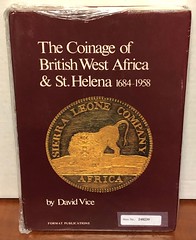 Kavan Ratnatunga writes:
Kavan Ratnatunga writes:
"I read an interesting article by numismatic researcher David Vice on the King's Norton Mint in Birminham and I need to ask him a question regarding these coins. He is the author of The Coinage of British West Africa & St. Helena, 1684-1958 "
Can anyone help Kavan get in touch? Thanks. -Editor
The Most Not Counterfeit Note Ever
John Ferreri writes:
"Starting in the mid 1800s the Suffolk Bank in Boston acted as a banknote clearing house for the many New England state or private banks. Their sometimes overbearing system was applauded by some and detested by others! The Federal Reserve System we have today, it is said, in many ways closely resembles the system used by the Suffolk Bank. The hundreds of state banks in business at the time throughout the New England States were subject to some banknote oversight by the Suffolk.
Counterfeit bank notes permeated the industry and had to be removed as efficiently as possible. If someone even inadvertently, presented a counterfeit, raised or spurious note to a teller at the Suffolk that note would quickly be given a stamp exclaiming that the note presented was "counterfeit" and then returned to the owner.
Not to be "bested" by the bank, it looks like the holder of this note devised a plan to be able to keep his note in circulation by adding a prefix to the stamp on the bill. Steve Noyes of Massachusetts, the current owner of this bill asked me if I thought anyone actually believed the new "imprimatur" affixed to his note."
Thanks. I can't not never say I've seen a not-counterfeit note like this before! Or not... -Editor
WWI AND WWII COIN TRENCH ART
Last week we discussed pocket change brought home by returning soldiers. Carol Bastable submitted these images of trench art made from coins by soldiers in WWI and WWII. Thanks! -Editor
To read the earlier E-Sylum article, see:
NOTES FROM E-SYLUM READERS: OCTOBER 3, 2021 : Coins From Returning Servicemen
(https://www.coinbooks.org/v24/esylum_v24n40a14.html)
2012 GOLD CASASCIUS 1000 BITCOIN GRADED
GreatCollections submitted a $48 Million Gold 1,000 Bitcoin Physical Coin for grading. Here's the press release. -Editor
Not seen for a decade, a one-ounce gold coin with a denomination of 1,000 Bitcoins (BTC) is the world's most valuable numismatic item. Purchased in December 2011 for $4,905, it is now worth $48 million at the BTC value as of Monday morning, October 4, 2021. On behalf of its anonymous owner, GreatCollections Coin Auctions of Irvine, California (www.GreatCollections.com) submitted the gold 1,000 Bitcoin physical coin under armed guard for certification to Professional Coin Grading Service. It has been certified PCGS Proof-70 DCAM.
This is the greatest return on investment for any numismatic item, a staggering 9,786 times the purchase price in just ten years. It may be the world's greatest investment in that time span,
stated Ian Russell, President of GreatCollections.
Its value eclipses classic coins, such as the 1933 Saint-Gaudens Double Eagle recently auctioned by Sotheby's for $18,872,250 or the Sultan of Muscat 1804 Draped Bust dollar GreatCollections recently purchased at auction for $7,680,000 on behalf of a client,
he said.
The gold 1,000 BTC is not for sale, but Russell announced that a gold-plated 25 BTC coin, now certified PCGS MS-67, will be offered without reserve by GreatCollections in an auction that closes on November 14.
Bidding will start at $1, although I anticipate this 25 BTC will sell for more than $1 million,
predicted Russell.
The cryptocurrency community refers to the 1,000 BTC coin as the Gold Cas.
That is a reference to Casascius
, the brand of BTC coins produced from 2011 to 2013. The company was created by Mike Caldwell to create physical Casascius coins
in increments of 0.1, 0.5, 1, 5, 10, 25, 100 and 1,000 BTC units. Caldwell also produced some BTC ingots.
PCGS Interim President Stephanie Sabin stated: "PCGS sets the standard for grading and authenticating rare coins, tokens, medals, and paper currency. As such, we have been entrusted with the encapsulation of the majority of auction-topping items year after year. This coin is set apart in its cultural significance in merging the worlds of cryptocurrency and traditional numismatics. Combine this with the staggering value of the Bitcoins it contains and we have a new Goliath."
Only six 1,000 gold BTC Casascius coins were made and four of them have not been redeemed including the one owned by Russell's client.
The gold coin is dated 2012 CASASCIUS.
The legend on the obverse includes 1 TROY OZ .999 FINE GOLD
and the motto, VIRES IN NUMERIS,
Latin for STRENGTH IN NUMBERS. There is a multi-color, tamper-resistant hologram design on the reverse. It was in fact the first produced by Casascius.
Russell said the current owner of this 1,000 gold BTC is not the presumed founder of the digital currency Bitcoin, Satoshi Nakamoto. There have been suggestions that the founder of Bitcoin owns iconic Bitcoin items such as the Gold Cas
.
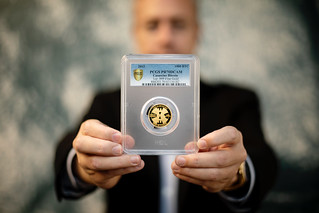
The Gold Cas owner wanted to have his fortune encapsulated and graded by PCGS. GreatCollections arranged the process from start-to-finish, including an armed guard escort to take it to PCGS headquarters in Santa Ana, California,
said Russell.
"It's the ultimate 21st century collectible, merging gold with crypto-currency; a cultural phenomenon considering the vast numbers of people under 30 who own some cryptocurrency as investments, he stated.
The $48 million coin now resides in an overseas bank vault, and it's unlikely to ever be redeemed or spent as Bitcoin, but you may be able to see it in person someday. GreatCollections is in talks with the owner to publicly display it at an upcoming coin convention,
Russell explained.
For additional information, contact GreatCollections at 949-679-4180 or visit online at www.GreatCollections.com.
Longtime E-Sylum readers may remember we discussed the Casascius physical bitcoins as early as 2011. Over 90,000 worth of these physical bitcoins were minted in various denominations. The 1000 BTC was the largest, but there were many more affordable (at the time) smaller denominations. Did any of our readers buy any? At publication time Sunday night bitcoin was trading at $54,912.62, making the value of the coin's 1000 BTC almost $55 million. See below for links to the earlier articles. -Editor
Bitcoins aren't just an abstract financial instrument living somewhere in the digital ether anymore. They're now a physical currency capable of taking a ride in your pocket or scratching off your lottery tickets.
The physical Bitcoins, called Casascius Bitcoins and created by a guy in Utah named Mike Caldwell, are made of brass, with gold electroplating on the 25 Bitcoin denomination. And, of course, they're tied to the peer-to-peer, open-source digital currency that's been exchanged on the Internet for a while now.
Each coin has a unique Bitcoin address and a redeemable "private key" under a hologram on the coin. That key can be used to redeem the value of the Bitcoins online, but the hologram sticker leaves a honeycomb mark when peeled back, so you'll know if your Bitcoins have been tampered with.
The coins play a function similar to a gift card or certificate with a magnetic strip or bar code. In other words, it provides a tangible means of carrying around the digital key that contains the actual value.
To read the earlier E-Sylum articles, see:
BITCOINS GO FROM VIRTUAL TO PHYSICAL
(https://www.coinbooks.org/esylum_v14n45a22.html)
U.S. GOVERNMENT SHUTS DOWN PHYSICAL BITCOIN MINTER
(https://www.coinbooks.org/esylum_v16n51a14.html)
WHY YOUR DIGITAL WALLET BELONGS ON YOUR FINGER
(https://www.coinbooks.org/esylum_v16n53a22.html)
THE CASASCIUS PHYSICAL BITCOIN
(https://www.coinbooks.org/v22/esylum_v22n28a23.html)
Aaron Oppenheim passed along a link to the Collectors Universe forum about the piece. Thanks. -Editor
yosclimber writes:
Cool story, but it has to compete with the Australian 1 Tonne (1000 kg) gold coin in terms of "most valuable". So the Australian 1 Tonne is currently valued $56.88 million, and beats $48 million for this 1000 bitcoin.
Weiss writes:
Fascinating. But I disagree that it is the world's most valuable coin. Scratching the combination to a safe stuffed with gold and jewels onto the surface of the coin doesn't make the coin valuable. It's the contents within the safe.
JBK writes:
If you write the bitcoin "key" on a piece of paper and seal that in an envelope, does that envelope become the most valuable philatelic cover/item in existence? If you lock the code in the glove compartment of your car, is your car now worth $48 million?
Perhaps the coin could be compared to a scratch-off lottery ticket, but a winning ticket needs to be surrendered, like a check, to be redeemed. In the case of the coin, it bears a code that is utilized digitally, independent of the coin.
ms71 writes:
It takes a great deal of faith to believe that the hidden "private key" is unknown and unknowable to anyone except the holder of the coin; or, indeed, that there is in fact a valid key beneath the hologram.
What exactly is PCGS certifying here? The holder states that it is a 2012-dated "Casascius Bitcoin 1oz .999 Find Gold." It also lists a denomination of "1000 BTC". But how could they certify that the unopened private key is there, correct and recoverable? Was the returned slab accompanied by a lengthy legal disclaimer? -Editor
To read the complete discussion, see:
The World's Most Valuable Coin - The Gold Cas - Currently $48 million (value 10 years ago was $4905)
(https://forums.collectors.com/discussion/1064427/the-worlds-most-valuable-coin-the-gold-cas-currently-48-million-value-10-years-ago-was-4905#latest)
In 2014 we discussed American artist Brad Troemel, I wrote, "Troemel's work as displayed here is legitimate and fully within the theme of modern "money artists" like J.S.G. Boggs. He discusses the Casascius Bitcoins and uses them in his work, along with other items we've discussed here in The E-Sylum, including NORFED coins and time-based community currencies." -Editor
Where is this artwork today? What is the denomination of that Casascius Bitcoin? -Editor
To read the earlier E-Sylum article, see:
MONEY ARTIST BRAD TROEMEL EXHIBITION
(https://www.coinbooks.org/esylum_v17n06a29.html)
Coincidentally, Stack's Bowers Director of Consignment and Numismatics James McCartney published a blog article about the firm's upcoming sale of a physical silver Lealana 0.1 Bitcoin. -Editor
Stack's Bowers Galleries is excited to present a physical Lealana Bitcoin to the passionate communities of cryptocurrency and numismatic enthusiasts in their November 2021 Showcase Auction. This physical Lealana Bitcoin represents a historic revolution in commerce, similar to the first gold coinage issued by King Croesus circa 500 BC and the first U.S. coins to be struck by steam press in 1836. It is the physical manifestation of an entirely digital concept, offering a fusion of numismatic utility and financial technology. It will be the very first piece of physical cryptocurrency offered in a major live auction.
It features an intrinsic face value, or "peel value," of 0.1 Bitcoin (BTC), equivalent to roughly USD$5,400 at the time of cataloging (October 2021). The value of this piece was buyer-funded and remains unredeemed, further increasing the desirability. Issued on a 25mm planchet of ¼ ounce of .999 fine silver and minted by Northwest Territorial Mint, the obverse features a holographic sticker with the serial number at left and the public address visible through a rectangular window. On the reverse is the Bitcoin currency symbol at center surrounded by a legend listing the denomination, composition, and the Hawaiian phrase "IKAIKA I HELU NUI" that translates as "Strength in Numbers." Also included with this physical Lealana Bitcoin is a Certificate of Authenticity (COA) and an encased Pretty Good Privacy (PGP) message.
First introduced as Lealana Litecoin, the Lealana series was released to collectors and investors in June 2013 as a counterpart to the Casascius physical bitcoins introduced in 2011. It was invented and issued by Noah Luis of Honolulu, Hawaii, who is perhaps better recognized within the crypto community by his internet handle "smoothie." These physical Lealana Bitcoins were produced in both brass and silver compositions and issued in a range of denominations from 0.1 BTC to 1 BTC, corresponding to those of the Casascius series. Only 2,000 Lealana 0.1 Bitcoins were issued in silver, and this buyer-funded example with a black address is a great rarity, one of only 10 issued. It is considered part of the limited Series 1 Lealana coins, offered before the address color was changed to green in May 2014 to comply with regulations.
We expect considerable excitement and fierce bidding among both collectors and investors when this piece crosses the auction block in our November sale.
To read the complete article, see:
Silver Lealana 0.1 Bitcoin (BTC) to be offered by Stack's Bowers Galleries in their November 2021 Showcase Auction
(https://www.stacksbowers.com/News/Pages/Blogs.aspx?ArticleID=lealana-physical-bitcoin-november-2021-showcase-auction)
VOCABULARY TERM: FLOW MARKS
Here's another entry from Dick Johnson's Encyclopedia of Coin and Medal Terminology. -Editor
Flow marks on a silver denarius of Antoninus Pius, from Forum Ancient Coins.
See:
Flow Marks and Halos on Roman Coins.
Flow Marks. Minute striations or corrugations on the surface of a freshly struck coin or medal. Flow marks are caused by the surface displacement of metal as the piece is struck, generally forming a microscopic pattern of ridges and channels – appearing to the naked eye as radial lines – which tend to form from the center outward toward the rim. They are best viewed in the field where no relief is present.
Flow marks on a struck piece are the cause of luster (also called mint luster) by reflecting light in a distinctive way; it is also the cause of cartwheel effect. The slightest wear or handling will diminish or erase flow marks (the minute channels fill with dirt, grease, human perspiration, oils, other contaminates or fluids the piece has come in contact with). This reduces the surface metal's unusual reflective quality, tarnish and wear begins.
Flow marks disappear rapidly as coins circulate or are handled; because of this they are an excellent criteria to distinguish true uncirculated pieces. (Collectors call the existence of flow marks a diagnostic of mint state where the piece has never been mishandled or circulated.)
In addition to wear or handling where contaminates fill the channels, any type of processing – polishing or whizzing – will remove flow marks. There is no known method of artificially returning flow marks once they have disappeared. They are very fragile, and once gone, cannot be restored.
Flow marks can be seen under low power magnification (3x to 10x) but are even more obvious under greater magnifications. Flow marks do not appear on proof coins because of the smooth polished surfaces, of both dies and planchets. Likewise in medallic work, any flow marks are removed by the finishing process. Thus flow marks are characteristic of uncirculated coins only.
White metal flow marks. An unusual situation exists for certain white metal alloys with high tin content. Flow marks on such pieces, where the metal stress is the greatest, will not tarnish but remain bright forever. The surface of certain white metal medals exhibit this phenomenon; the remainder of the piece will tone or tarnish (actually turn dark gray to black), but the flow mark high stress areas will remain bright. Thus the bright area is a reverse bright "shadow" in contrast to the naturally dark toned surface. See white metal.
To read the complete entry on the Newman Numismatic Portal, see:
Flow Marks
(https://nnp.wustl.edu/library/dictionarydetail/515937)
HARVEY STACK'S NUMISMATIC FAMILY, PART 106
The latest article in Harvey Stack's blog series covers the first half of the banner auction year of 1989. Thanks, Harvey! -Editor
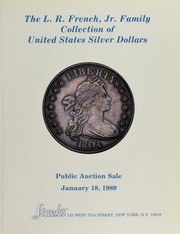 Stack's auction program for 1989 was large and important. This was the second year since the 20% drop of the Stock Market on "Black Monday," October 19, 1987. While things were recovering, it was a slow process. and the effects were felt for two years. This drop had been caused by the failure of the bond market to make promised payments and interest to many investors, leading to a wild sell off. During this period hobbies slowed down, but the numismatic market seemed to stay basically stable, as many collectors continued to enjoy the hobby and see coins as a store of value. The 13 auctions we conducted in this year reflected some clients who were ready to stop collecting, some who had passed away, and others who were interested in new specialties. A large majority of our sales in 1989 were "name" collections, and these always attracted great attention and active bidding.
Stack's auction program for 1989 was large and important. This was the second year since the 20% drop of the Stock Market on "Black Monday," October 19, 1987. While things were recovering, it was a slow process. and the effects were felt for two years. This drop had been caused by the failure of the bond market to make promised payments and interest to many investors, leading to a wild sell off. During this period hobbies slowed down, but the numismatic market seemed to stay basically stable, as many collectors continued to enjoy the hobby and see coins as a store of value. The 13 auctions we conducted in this year reflected some clients who were ready to stop collecting, some who had passed away, and others who were interested in new specialties. A large majority of our sales in 1989 were "name" collections, and these always attracted great attention and active bidding.
The year started off with our January sale of the L.R. French, Jr. Collection of United States Silver Dollars, just over 200 lots. It started with a 1794 silver dollar in Mint State, and continued through each early date issued, including 1801, 1802, 1803 in Brilliant Proof, as well as the Adams-French 1804 dollar. Issues from the Gobrecht series and most of the Liberty Seated coins were in Proof, and there was a superb 1870-S from the Fairbanks Collection. Morgan and Peace dollars in Mint State and Proof were presented along with an extraordinary set of trade dollars, highlighted by the rare 1884 and 1885.
In that same month, Stack's presented the Stanley Simon Collection of United States Gold, Silver and Copper Coins, 1,467 lots of U.S. coins, highlighted by this gentleman's type collection, and featuring mostly Proof and Mint State pieces.
March 1989 brought our sale of an extensive collection formed by Howard W. Gunlocke of high quality United States gold, silver, and copper coins, starting with the first years of issue, along with a large collection of U.S. paper money. This sale included 2,246 lots in all. In April, we were able to offer a sale of nearly 1,000 lots of Ancient and Foreign gold, silver, and copper coins that included many popular rarities.
May brought another famous name collection, the Herman Halpern Collection of United States Gold Coins. It started with a type set of U.S. gold coins, all in high quality that Mr. Halpern had built over the years, adding choice examples as they became available, mostly from Stack's inventory and our Public Auctions. Besides wonderful early gold issues, the sale was highlighted by a 1890 gold Proof set and a 1915 Panama Pacific set in the original box of issue. While only 330 lots, this extraordinary collection attracted a room full of collectors. May also brought to the auction block the New Jersey Collection of U.S. Gold, Silver and Copper Coins, plus the John M. Foreman, Sr. Collection that featured all series of U.S. coins. These collections (a total of 1,130 lots) along with the Halpern Collection made up our sale in conjunction with the Greater New York Numismatic Convention, always a popular venue for our auctions.
In June we brought to auction A Southern Gentleman's Collection of United States coins, a diverse offering that featured something for all collectors. This comprehensive collection comprised 2,872 lots and featured extensive dates and mints in each denomination. While the first half of the year had been very busy and exciting, there was more to come in 1989, which I will describe in my next article.
To read the complete article, see:
Harvey Stack Remembers: Growing up in a Numismatic Family, Part 106
(https://www.stacksbowers.com/News/Pages/Blogs.aspx?ArticleID=harvey-stack-remembers-106)
To read the earlier E-Sylum article, see:
HARVEY STACK'S NUMISMATIC FAMILY, PART 105
(https://www.coinbooks.org/v24/esylum_v24n39a22.html)
CANADA'S OLDEST COIN DEALER
An article headlined "Canada's oldest coin dealer" discusses the Montreal firm of Carsley Whetstone. Here's an excerpt. See the complete article online. -Editor
For more than 90 years, the professionals behind Carsley Whetstone have spearheaded specialized dealing in coins as well as other unique precious items such as jewellery in Montreal. Started in 1928, the company has a storied past of professionalism and expertise that has culminated in what Carsley Whetstone is today.
A couple named Mr. and Mrs. Carsley had a shop on Ste. Catherine Street that sold all kinds of things, including coins, and coins became a bigger part of their business,
explained current owner Michael Joffre. In the 1980s, another company, Thompson & Whetstone, who were antique dealers that also dealt with coins, bought Carsleys, bringing together two older Montreal institutions.
In the late 1990s, Joffre started working for Carsley Whetstone after giving up his career as a stockbroker.
I had always been a very serious coin collector and would spend a lot of my disposable income on coins, so I bought part of the company and, in 2005, I bought out everyone else,
he said, adding, I gave up my career to do what I love.
Not only does history and know-how back this historic company, but so does Joffre's enthusiasm for what he does.
I do it because it's my passion. You'll meet passionate people who really love coins when you come here,
he said. Almost all the people who have worked here have been here for a long time. There isn't a huge turnover.
They pride themselves on specializing in rare coins and paper money, but they also buy gold jewellery, and deal in historical and military medals. One of the founders was a world expert on silver hallmarks and has published many books on the subject. Carsley Whetstone are also experts in silver objects. Sixteen years ago, they also started dealing in modern collectibles such as rare comic books as well as trading cards.
We are on the corner of Ste. Catherine Street and Peel and have been in the same building for 30 years,
Joffre explained. We have had various locations over 93 years but both companies have always been on Ste. Catherine. We really are a traditional Montreal company.
To read the complete article, see:
Carsley Whetstone: Almost a century of experience behind Canada's oldest coin dealer
(https://www.thesuburban.com/profiles/business_profiles/carsley-whetstone-almost-a-century-of-experience-behind-canada-s-oldest-coin-dealer/article_1a5bc164-283f-11ec-8462-27b141e23b06.html)
2022 NYINC MOVES TO NEW LOCATION
The New York International Numismatic Convention is moving to a new venue for 2022. Here's the announcement. -Editor
 The 50th Annual New York International Numismatic Convention is moving to a
new site according to Bourse Chairman Kevin Foley, who said:
The 50th Annual New York International Numismatic Convention is moving to a
new site according to Bourse Chairman Kevin Foley, who said: Although our
event has for several years been under contract at the Grand Hyatt New York, that
hotel remains closed due to the impact of the Covid pandemic. Because of the
uncertainty this closure presented for our attendees, as well as the Grand Hyatt, we
reached an amicable agreement with the Grand Hyatt management for the
NYINC to relocate. Our new site will be the InterContinental Barclay hotel,
located at 111 East 48th Street at Lexington Avenue, just one block south of our site
from 2001 until 2017, the Waldorf-Astoria
.
Auction lot viewing will open on Friday, January 7. Auction sessions will be held each day from Monday, January 10 through Sunday, January 16. Our four day bourse area, with roughly 100 of the leading specialists in world and ancient numismatics, gets underway with the 12noon-7PM Early Bird day on Thursday, January 13. The regular public hours will be 10AM-7PM on Friday and Saturday, January 24 and 15 and 10AM-3PM on Sunday, January 16.
There is a $125 registration fee for the January 13 Early Bird day. Admission during the regular Friday-Sunday public hours is $20 for a pass valid all three days, with $5 discount coupon is available on the NYINC website.
The InterContinental Barclay is characterized by luxury and style. Since first opening its doors in 1926 the Barclay has welcomed countless guests to enjoy a luxurious residential experience. Having undergone an extensive restoration project within the last five years the Barclay is one of Manhattan's premier luxury hotels.
Located in the heart of midtown Manhattan, the Barclay is convenient to the theater district, Madison Avenue and Park Avenue shopping, Rockefeller Center, multiple dining opportunities and the United Nations.
Foley continued, The NYINC has for many years been a truly special event,
attracting booth holders, Early Birds and public attendees from across the United
States, as well as a broad representation of foreign countries. We'll once again have our format of a full week of world and ancient specialty auctions, educational
programs and our four day specialty bourse focused exclusively on foreign and
ancient numismatic material. Details are available on our website,
http://www.nyinc.info/
.
Foley expanded on his remarks by addressing Covid precautions by saying,
There is one very important difference between our 2022 convention and past
NYINC events that is caused by the Covid pandemic. New York City regulations
require the presentation of Covid vaccination documentation, either a vaccination
card or other written or electronic evidence of vaccination is required for
admission to and participation in events such as ours. The mandatory regulations
we are required to follow make no provision for exemptions or exceptions of any
kind, so everyone, our staff, our booth holders and our attendees will need to be
able to show such documentation when they check in.
For more information, or to book a room, see:
http://www.nyinc.info/
WBNA RAQMU COLLECTION OF JORDAN SALE
Here's the announcement for the latest World Banknote Auctions sale, a specialized collection of the banknotes of Jordan. -Editor
World Banknote Auctions presents the Raqmu Collection of Jordan, which has now been posted to its website, www.worldbanknoteauctions.com. This collection, put together over several decades by a dedicated collector, contains both issued notes, specimens and proofs. It is highlighted by a complete specimen book of the second issue, prepared by Thomas de La Rue as a presentation piece in 1955. The entire collection contains 182 lots, ranging from the first issue dated 1949 to the series introduced in 2002.
The Live Sale takes place on our website and through our Mobile Apps on Thursday, November 4 at 1 PM EST / 10 AM PST. As usual, buyer's premium is kept at a modest 15% ($5 minimum per lot) and shipping is flat-rate, $10 within the United States and $25 overseas. We have created our first printed catalog for this collection. A limited number of copies will be distributed at the Den Bosch Paper Money Fair in the Netherlands held October 23/24. We will also have select highlights on display at our table, K-8. If you are not attending the show you can purchase a copy of the printed catalog for a minimal cost below.
To download the printed catalog, see:
Raqmu Collection of Jordan
(https://mcusercontent.com/c039ea4babc5772fe79b66ca2/files/d44c580c-4683-d5e2-9d26-6e977ce59c8c/Raqmu_OnlineCatalog.02.pdf)
Raqmu Collection Highlights
Lot 17010: Jordan 1949 P-2b PMG Gem UNC 65 EPQ 1 Dinar
Lot 17018: Jordan 1949 (ND 1952) P-5Ac PMG Choice UNC 64 500 Fils
Lot 17033: Jordan 1949 (ND 1952) P-7as PMG Choice UNC 64 5 Dinars (Specimen)
Lot 17040: Jordan 1949 (Dated 1955) Thomas de la Rue Specimen Book
Lot 17084: Jordan ND (1959) P-16dcts PMG Gem UNC 66 EPQ 10 Dinars (Color Trial Specimen)
Lot 17122: Jordan 1977 P-21p UNC 20 Dinars (Front and Back Proofs on Cardboard With Approval Autographs)
Lot 17172: Jordan 1995 / AH1415 P-32cts PMG Gem UNC 66 EPQ 20 Dinars (Specimen Proof)
Lot 17181: Jordan 2002 / AH1423 P-37a PMG Superb Gem UNC 68 EPQ 20 Dinars
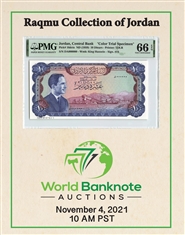
The catalog of this specialized collection will be a great reference work, and hardcopies are available for about $17 in the U.S. ($9.97 plus shipping and handling, which is about the firm's cost). -Editor
To purchase the printed catalog, see:
Raqmu Collection of Jordan
(pp.thebookpatch.com/BookStore/raqmu-collection-of-jordan/e871dda1-419b-4ce7-839f-9248388a9ff3)
DNW IAN SAWDEN COLLECTION OF BRITISH COINS
This week's Dix Noonan Webb sale of the Ian Sawden Collection of British Coins includes some top material related to Matthew Boulton's Soho Mint. Here's the press release. -Editor
Two gold halfpennies dating from the late 18th century from the important Soho Mint, which was created by Matthew Boulton in 1788 in his Manufactory in Handsworth, West Midlands are both expected to fetch £20,000-26,000 when sold by international coins, medals, banknotes and jewellery specialists Dix Noonan Webb on Tuesday, October 12, 2012. From the Ian Sawden Collection of British Coins, the Collection is expected to fetch more than £200,000. Comprising 208 coins spanning eight monarchs from George I to George VI (1727-1952), the majority of the coins are from the reigns of George III and Queen Victoria.
Peter Preston-Morley, Head of Coin Department at Dix Noonan Webb, comments: We are very pleased to be offering this Collection which reflects the strength of the Manufactory of Matthew Boulton and the coins struck from Boulton dies by the medalist W.J. Taylor in the mid 19th century.
A selection of 1788, 1797 and 1799 coinage that was produced in the Soho Mint, which was created by Matthew Boulton in 1788 in his Soho Manufactory in Handsworth, West Midlands, England highlight the sale. A 1797 Cartwheel proof gold Penny from the reign of George III (1760-1820) that is decorated with a laureate bust wearing a wreath with 10 leaves is estimated at £20,000-26,000. This coin was once in the Collection of King Farouk and is believed that only one other is known to exist. A spectacular and rare 1788 Pattern gold Halfpenny depicting Britannia seated with a spear is also estimated at £20,000-26,000.
From the reign of Queens Victoria (1837-1901) is an extremely rare Proof Florin dating from 1862. This is one of two in the sale and this example is estimated at £5,000-7,000, while carrying a similar estimate is a Proof Florin dating from 1848 – one of 12 examples in the sale. From the reign of Queen Victoria (1837-1901), this is a very rare coin.
Ian Sawden was born in the UK and began by collecting miscellaneous coins, mostly Victorian bun pennies which were generally in very worn condition. He moved overseas in 1976, that collection was disposed of and collecting coins was forgotten as there were more interesting activities to occupy the day.
His interest was rekindled in 2006 when, walking down a street in Toronto, he spotted a Cartwheel twopence in the window of a dealer and bought it. This lead to Ian researching the history of the Soho coinage and the spark was lit. From that chance encounter, he began collecting a variety of coinage, aiming for quality rather than quantity. Apart from George III he developed a particular interest in the coinage of William IV and the young head issues of Victoria, attracted by their exquisite engraving. Buying a copy of Charles Wilson Peck's English Copper, Tin and Bronze Coins in the British Museum 1558-1958 allowed him to identify groups of coins and he discovered the many intriguing patterns to be found: a new focus had arrived.
As the collection grew Ian decided to reduce its scope and concentrate on certain themes, such as pennies and halfpence of George III, evidenced by the range of Soho coinage in this catalogue. He also expanded the scope of the collection to focus on key dates of different denominations and the silver coinage, particularly florins.
For more information, see:
https://www.dnw.co.uk/
SEDWICK TREASURE AUCTION 30 ANNOUNCED
Here's the announcement for November's Daniel Frank Sedwick sale. -Editor
Treasure, World, U.S. Coin and Paper Money Auction 30
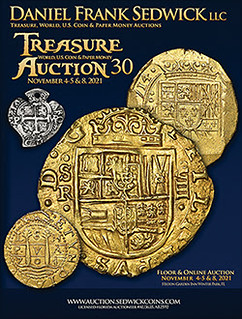 We're excited to host our first live floor auction since the beginning of the pandemic over a year and a half ago. While our past three online-only sales were immensely successful and record-breaking, we missed visiting with the many bidders that attend our live floor auctions. There's something to be said about bidding on and seeing these treasures in person, which is why we're grateful to be at this point.
We're excited to host our first live floor auction since the beginning of the pandemic over a year and a half ago. While our past three online-only sales were immensely successful and record-breaking, we missed visiting with the many bidders that attend our live floor auctions. There's something to be said about bidding on and seeing these treasures in person, which is why we're grateful to be at this point.
Session I begins with Gold Cobs, which hosts a number of choice 1715 Fleet coins including a 1711 J Mexico cob 8 escudo Royal (lot 16), an extremely rare 1714 Mexico cob 8 escudos struck with a Royal obverse die (lot 18), one of the nicest 1712 Lima 8 escudos we've ever handled (lot 29), and a fascinating 1702 Bogotá cob 2 escudos with the date rendered as 2071
reading outward (lot 63). Notable non-wreck gold cobs in this section include a 1698/7 M Seville 8 escudos plated in both Calicó and Tauler reference works (lot 14), plus a rare and unlisted 1751 S Bogotá cob 8 escudos (lot 58). The latter is pedigreed to the featured Fernandina Collection, a curated group of some very high grade and rare gold cobs, both wreck and non-wreck, that will no doubt attract much attention.
The Shipwreck Ingots section is strongly influenced by lots from the Atocha (1622) due to next year's 400th anniversary of the sinking. We feature one impressive gold finger
bar (lot 67) from the wreck alongside a total of five large silver ingots (lots 71-75). Coins from the Atocha feature prominently in Shipwreck Coins with some 70+ lots up for bidding, including a very rare Lima cob 2 reales Philip II assayer X (lot 87). Other lots of note include coins from the Capitana (1654) and Maravillas (1656) wrecks pedigreed to the Mastalir Collection of Countermarked Potosí cobs, a wide selection of Dutch portrait and rider ducatoons from the Akerendam (1725)(lots 288-332), our first offering of an NGC-graded Mexico cob 8 reales from the pirate ship Whydah (1717)(lot 280), and an assortment of world and US gold coins salvaged from the popular SS Central America (1857)(lots 396-406).
In Mexico Silver Cobs, we offer several extremely rare cob 8 reales Royals like a 1613 F (lot 424), a 1706 J (lot 430), and a 1715 J (lot 432) in addition to a desirable 1728/6/5 D pedigreed to the Rooswijk (1739). Lima Silver Cobs hosts the quite rare 1686 R Lima cob 8 reales Royal (Lot 490) in addition to several other rare types. Many more rare Royals can be found in the Potosí Silver Cobs section including a very difficult to acquire 1656 E Potosí cob 8 reales Royal (lot 635). Bidders' hearts will be beating strongly for lots 741 and 808 - the finest and only graded 1696 VR cob 4 reales and 1734 E cob 1 real Hearts. Two key collections within this session are the Barry Stallard Research Collection of Early Lima, La Plata and Potosí Cobs (see lot 505 for the immensely rare La Plata piece) and the Jorge Ugaz Collection of Potosí Cob 8 and 4 Reales.
On the second day of the auction, the wide selection found in World Coins should draw spirited bidding from all over the world. Such rarities there include a fresh-to-the-market Japanese proof 20 sen dated Meiji year 13 (1880)(lot 1173), two Segovia-minted rarities - a gold 4 excelentes of Ferdinand-Isabel (lot 1276) and a massive 50 reales cincuentín dated 1620 (only our second offering of this rare denomination!) (lot 1315), and the finest NGC-graded 1745 MF Mexico pillar 8 reales (lot 1184). Also an special selection of gold Chilean coins recovered from La Luz wreck (854-865). The presence of a 1621 A Cartagena (Colombia) cob 8 reales from the Dry Tortugas wreck
(1622) as lot 885 is especially fitting as this year is the 400th anniversary of the striking of these first coins from the mint in Cartagena - an event we will be celebrating in December while attending the Cartagena Numismatic Congress.
We are very pleased to offer several collections within this session: the exclusive J.O.B. Collection of Seville Gold Coins (lots 1251-1275) packed with many finest and only known graded pieces, the Tamarindo Collection of Costa Rican Error Coins and Paper Money, and Part II of the Antigua Collection of Guatemalan Cobs.
One further collection to note is the John Adams Collection of Admiral Vernon Medals in Medals and Decorations. His feature article preceding the lots explains his personal collecting journey how this top-notch collection came to be.
U.S. Coins and Paper Money hosts some branch-mint gold coins from Dahlonega (lot 1411) and Charlotte (lot 1415) plus some popular early American currency like the 1798 Draped Bust silver dollar (lot 1419), the 1794 Flowing Hair large cent (lot 1434), and the grade-rarity 1777-dated South Carolina $20 colonial note (1451). World Paper Money contains some desirable type notes such as the Argentina 1 peso remainder of 1827-9 with portraits of Washington and Bolívar (lot 1456), the rare Cartagena (Colombia) Estado Soberano de Bolívar 10 pesos note of 1885 (lot 1459), and the spectacular Banco Internacional de Costa Rica 100 colones error note dated to the year 2931
(lot 1464).
Following an assortment of popular Greek, Roman, and Byzantine coinage designs in Ancient Coins, the Coin Jewelry section offers a wealth of mounted Atocha (1622) silver coins (lots 1540-1568) plus a visually impressive 1714 J Mexico gold cob 8 escudos in a special 1715 Fleet pendant setting (lot 1537).
Shipwreck Artifacts has many interesting salvaged items such as a pocket sundial from the HMS Winchester (1695), previously seen in a 1977 issue of National Geographic magazine (lot 1589), as well as an ornate gold toothpick from the 1715 Fleet (lot 1590). Finally, some notable lots in Non-Wreck Artifacts include an arsenal of flintlock pistols (lots 1605-1610) plus a long Spanish miquelet officer's musket (lot 1604). The following Monday, we end the auction with an Express session with 400+ lots of lower priced coins, currency, and artifacts.
For more information, see:
https://auction.sedwickcoins.com/auctionlist.aspx
STACK'S BOWERS JOHN ADAMS BOLEN MEDAL SALE
This Stack's Bowers emailed an announcement about a collection of Bolen medals in their November sales. -Editor
of the Medals of John Adams Bolen
Featured in the November 2021 Showcase Auction
This landmark offering is one of the largest ever of Bolen's works. It is singularly important, as the core of this offering includes dozens of medals from John Adams Bolen's personal collection—medals that have never before been offered at public auction. Nearly 100 different medals are included in the presentation, including great rarities such as Bolen's George Clinton, Standing Indian and Eagle on Globe copper plate, one of two produced and the only offering of one since the 1884 sale of the Isaac F. Wood Collection. The Bolen pieces from the E Pluribus Unum Collection, along with other important Numismatic Americana from this cabinet, will be featured in the Stack's Bowers Galleries November 21-23, 2021 Official Auction of the Whitman Coin & Collectibles Winter Expo.
Dig out your copies of Neil Musante's great 2002 book The Medallic Work of John Adams Bolen! -Editor
NUMISMATIC NUGGETS: OCTOBER 10, 2021
Here's a selection of interesting or unusual items I came across in the marketplace this week. Tell us what you think of some of these. -Editor
ISLES OF FRANCE & OF BOURBON. French Administration. 5 Livres, 1795. P-Unlisted. PMG Very Fine 20.
(UNL5a). Isle de la Reunion. Troisieme Emission. An incredibly scarce & early 5 Livres note. Three of the four margins offer plentiful paper. The penned signature and serial number remain dark & legible. A historical offering for Reunion & French paper money collectors. PMG comments "Insect Damage".
From the October 2021 Stack's Bowers World Collectors Choice Online Auction -Editor
To read the complete lot description, see:
ISLES OF FRANCE & OF BOURBON. French Administration. 5 Livres, 1795. P-Unlisted. PMG Very Fine 20.
(https://auctions.stacksbowers.com/lots/view/3-TSNVD/isles-of-france-of-bourbon-french-administration-5-livres-1795-p-unlisted-pmg-very-fine-20)
1838 U.S. Large Cent
Countermarked "D. G. BENTLEY & CO / NORWICH CT // PERESCOPIC . GLASSES"
This is the finest of two known examples.
The "PERESCOPIC . GLASSES" mark is stamped neatly between the "ONE" and "CENT" on the reverse. The name and city marks are stamped on the obverse.
Research from the book "Ophthalmologia Optica & Visio in Nummis", by J.M. Galst and P. Van Alfen, 2018, page 448:
A lens manufacturer named D. G. Bentley advertised in the Norwich, Connecticut newspaper Aurora in 1839 and 1842 that he made perescopic spectacle lenses using steam power. Periscopic spectacles (also known as "wide field spectacles") are those with either menisci or concavoconvex lenses, with the concave surfaces towards the eyes, allowing the eyes extra latitude of motion. They were invented by W. H. Wollaston of Great Britain in the early 19th century. [A different example of this countermark is also shown in the book, on a US Draped Bust Large Cent (1796-1807).]
David Gardner Bentley was born in Norwich, New London County, Connecticut in February 1810. He was married on 22 April 1833, and he died on 01 May 1845. He is listed in the US Federal Census for 1840 in Norwich, New London County, Connecticut.
Brunk B-573.
Issuer: David Gardner Bentley (b.1810 - d.1845)
Business/Profession: Perescopic Glasses
Date of issue: 1838-1845
Place of issue: Norwich, New London County, Connecticut
From Bob Merchant's eBay offerings. Neat counterstamp. -Editor
To read the complete lot description, see:
1838 1C Counterstamp "D.G. BENTLEY & CO / NORWICH CT / PERESCOPIC GLASSES" (Lens
(https://www.ebay.com/itm/133895220348)
1879 Pattern Morgan Dime. Judd-1589, Pollock-1782. Rarity-7-. Copper. Reeded Edge. Proof-67 Cameo (PCGS).
An elusive and highly-prized rarity from the Morgan pattern series. The obverse depicts George T. Morgan's famed Liberty head used on the silver dollar of that year, with legend surrounding and date below. On the reverse a continuous wreath of laurel with berries is seen, with an inner beaded border which contains E PLURIBUS UNUM and ONE DIME along with 13 tiny stars.
As noted on USPatterns.com, there are perhaps 12-15 known of this issue, most are in high grades in varying copper categories from brown to red.
What a great piece! The reverse looks like a piece overstamped with another die. Interesting, and very distinctive. Offered at fixed price by Stack's Bowers. -Editor
To read the complete lot description, see:
1879 Pattern Morgan Dime. Judd-1589, Pollock-1782. Rarity-7-. Copper. Reeded Edge. Proof-67 RD Cameo (PCGS).
(https://www.stacksbowers.com/pages/lotinfo.aspx?LotId=1530362)
A superb gem example from a low mintage of 846 coins struck in proof format. Untoned central devices are framed by beautifully clean mirrors touched with pretty champagne iridescence. Considerable contrast and fantastic eye appeal!
What a gorgeous coin! This knocked my socks off. From the David Lawrence Rare Coins inventory. -Editor
To read the complete lot description, see:
1899 $1 PCGS Proof 66 ex: Jack Lee
(https://www.davidlawrence.com/rare-coin/2303628)
To read the complete lot description, see:
Authentic Trade Token Australia Tea Mart - Hanks &
(https://www.liveauctioneers.com/item/114118582_authentic-trade-token-australia-tea-mart-hanks-and)
2022 AMERICAN WOMEN QUARTERS DESIGNS
This week the U.S. Mint announced design choices for the 2022 American Women quarters. Here's the press release. -Editor
The United States Mint (Mint) is pleased to announce the official designs for the first five coins in the American Women Quarters Program. Authorized by Public Law 116-330, this four-year program features coins with reverse (tails) designs emblematic of the accomplishments and contributions of trailblazing American women. Beginning in 2022 and continuing through 2025, the Mint will issue five quarters in each of these years. The ethnically, racially, and geographically diverse group of individuals honored through this program reflects a wide range of accomplishments and fields, including suffrage, civil rights, abolition, government, humanities, science, space, and the arts. The 2022 coins recognize the achievements of Maya Angelou, Dr. Sally Ride, Wilma Mankiller, Nina Otero-Warren, and Anna May Wong.
These inspiring coin designs tell the stories of five extraordinary women whose contributions are indelibly etched in American culture,
said United States Mint Acting Director Alison L. Doone. Generations to come will look at coins bearing these designs and be reminded of what can be accomplished with vision, determination and a desire to improve opportunities for all.
2022 Reverse Designs
The Secretary of the Treasury selected the final designs in accordance with the design selection process, which is available here. All reverse designs were created by United States Mint Artistic Infusion Program (AIP) Designers and sculpted by United States Mint Medallic Artists.
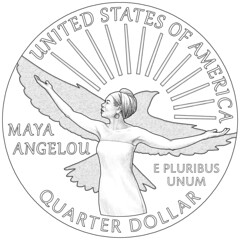 Maya Angelou—celebrated writer, performer, social activist
Maya Angelou—celebrated writer, performer, social activist
Designer: Emily Damstra, AIP Designer
Sculptor: Craig A. Campbell, Medallic Artist
The design depicts Maya Angelou with her arms uplifted. Behind her are a bird in flight and a rising sun, images inspired by her poetry and symbolic of the way she lived. Inscriptions are UNITED STATES OF AMERICA,
MAYA ANGELOU,
E PLURIBUS UNUM,
and QUARTER DOLLAR.
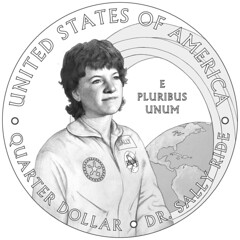 Dr. Sally Ride—physicist, astronaut, educator, and first American woman to soar into space
Dr. Sally Ride—physicist, astronaut, educator, and first American woman to soar into space
Designer: Elana Hagler, AIP Designer
Sculptor: Phebe Hemphill, Medallic Artist
This design depicts Dr. Ride next to a window on the space shuttle, inspired by her quote, But when I wasn't working, I was usually at a window looking down at Earth.
The inscription E PLURIBUS UNUM
is intentionally positioned over the Earth next to America, indicating that out of all women in the United States, Dr. Ride was the first into space. The additional inscriptions are UNITED STATES OF AMERICA,
QUARTER DOLLAR,
and DR. SALLY RIDE.
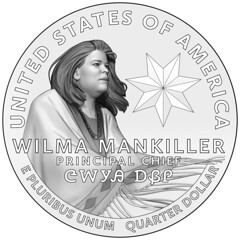 Wilma Mankiller—first woman elected principal chief of the Cherokee Nation and an activist for Native American and women's rights
Wilma Mankiller—first woman elected principal chief of the Cherokee Nation and an activist for Native American and women's rights
Designer: Ben Sowards, AIP Designer
Sculptor: Phebe Hemphill, Medallic Artist
This design depicts Wilma Mankiller with a resolute gaze to the future. The wind is at her back, and she is wrapped in a traditional shawl. To her left is the seven-pointed star of the Cherokee Nation. Inscriptions are UNITED STATES OF AMERICA,
E PLURIBUS UNUM,
QUARTER DOLLAR,
WILMA MANKILLER,
PRINCIPAL CHIEF,
and CHEROKEE NATION,
which is written in the Cherokee syllabary.
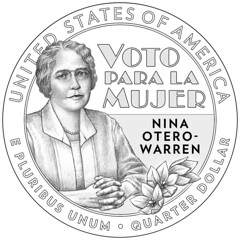 Nina Otero-Warren—a leader in New Mexico's suffrage movement and the first female superintendent of Santa Fe public schools
Nina Otero-Warren—a leader in New Mexico's suffrage movement and the first female superintendent of Santa Fe public schools
Designer: Chris Costello, AIP Designer
Sculptor: Craig A. Campbell, Medallic Artist
The design features an image of Nina Otero-Warren on the left, flanked by three individual Yucca flowers—New Mexico's state flower. Inscriptions are UNITED STATES OF AMERICA,
QUARTER DOLLAR,
E PLUIBUS UNUM,
NINA OTERO-WARREN,
and VOTO PARA LA MUJER,
the Spanish counterpart for the suffragist slogan Votes for Women.
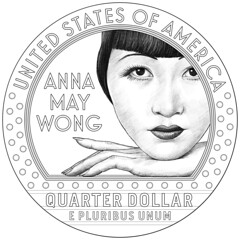 Anna May Wong—first Chinese American film star in Hollywood, who left a legacy for women in the film industry
Anna May Wong—first Chinese American film star in Hollywood, who left a legacy for women in the film industry
Designer: Emily Damstra, AIP Designer
Sculptor: John P. McGraw, Medallic Artist
This design features a close-up image of Anna May Wong with her head resting on her hand, surrounded by the bright lights of a marquee sign. Inscriptions are UNITED STATES OF AMERICA,
E PLURIBUS UNUM,
QUARTER DOLLAR,
and ANNA MAY WONG.
Common Obverse (Heads) Design
The obverse design of all coins in the American Women Quarters Program is by Laura Gardin Fraser, one of the most prolific female sculptors of the early 20th century, whose works span the art and numismatic worlds. Fraser's design depicts a portrait of George Washington, which was originally composed and sculpted as a candidate to mark George Washington's 200th birthday. Though recommended for the 1932 quarter, then-Treasury Secretary Mellon ultimately selected the familiar John Flannigan design. Inscriptions are LIBERTY,
IN GOD WE TRUST,
and 2022.
To read the complete press release, see:
United States Mint Announces Designs for 2022 American Women Quarters™ Program Coins
(https://www.usmint.gov/news/press-releases/united-states-mint-announces-designs-for-2022-american-women-quarters-program-coins)
I particularly like the Maya Angelou and Anna May Wong designs, both of which are by Emily Damstra. Less is more.
Wayne Pearson shared this letter he wrote endorsing the use of the Laura Gardin Fraser eagle design. -Editor
Dear Representative Barbara Lee,
I am writing to you about H. R. 1923 Circulating Collectible Coin Redesign Act of 2020/ Public Law 116-330.
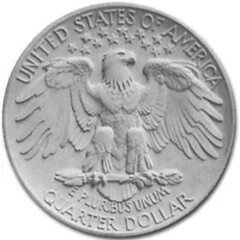 I am requesting, that during this 2022-2025 quarter series, in addition to using 5 women per year, that we also use the Laura Gardin Fraser eagle that was originally paired with the Washington design in 1932.
I am requesting, that during this 2022-2025 quarter series, in addition to using 5 women per year, that we also use the Laura Gardin Fraser eagle that was originally paired with the Washington design in 1932.
In 2009 we had six territorial quarters.
I think we can have five quarters honoring women and a sixth with Laura's eagle each year for these three years.
After all, the coin collectors are the ones expected to buy all of these quarters and we've been waiting for this complete Laura Gardin Fraser design since 1932 on a circulating quarter.
Would you please consider an amendment to the bill, adding the Laura Gardin Fraser eagle reverse to the five women quarters designs?
It would go a long way in the coin collecting community.
Thank you
It would be nice to see that design produced. I'm always of two minds on new coinage. While I appreciate and like to see classic coin designs (whether previously produced or just proposals), I also enjoy seeing what today's artists come up with - these can be just as high quality as work from the past. But with the large number of issues being produced, it would be nice to see some earlier unused designs finally have their day in the sun. It would be quite appropriate to pair Laura Gardin Fraser's designs. -Editor
Wayne adds:
"I think a lot of the designs from the past were overlooked for a variety of reasons. I had come up with six reasons but anymore I can only recall three.
"First, using the seated Liberty design as an example, it was on the half dime, dime, twenty cent piece, quarter, half dollar and dollar. If each coin had its own design many designs could have been used. And Barber didn't help us in 1892 when he decided to use his work and the same design on three coins. And if our coin designs changed every 25 years instead of allowing them to go on and on more designs could be used. The seated Liberty design started in the late 1830's and wasn't finished until 1891 on the final three coins.
"Second, if you became the chief engraver, no matter how many great patterns/ideas existed, you wouldn't want to use them and give credit to someone else, you would want to use your own work. And it would be the same for the next chief engraver.
"Lastly, when a designer is tasked to come up with something they generally make multiple different designs. In Morgan's case, his Shield Earring and School Girl designs were great, but there was only one coin opening. That is why there are so many still unused pieces of work from the past. And we can't forget the politics of things when we're talking about Laura Gardin Fraser's quarter design."
NEW CALIFORNIA FRACTIONAL GOLD VARIETY
Discovering a new variety in a long-studied series is always an exciting development in numismatics. This press release from Stack's Bowers describes an interesting new die pairing in the California fractional gold series. "BG" stands for Breen-Gillio, California Pioneer Fractional Gold, the standard reference for Fractional Gold by Walter Breen and Ron Gillio. -Editor
New 1854 Period 1 California Fractional Gold Dollar Variety Discovered
A new die variety of California Fractional Gold Dollar has been discovered by Ken Glickman, an avid collector and researcher of California Fractional Gold for more than two decades. The new variety has been confirmed by California Fractional Gold specialists Ronald J. Gillio, Robert D. Leonard, Jr. and John Pack. The new variety designation for this unique specimen will be listed as BG-526a, as that comes between BG-526 (1853) and BG-527 (1854) in the BG reference book.
The new specimen's obverse is the same as that of BG-526, and is easy to match, as follows: There are three prominent die cracks (one above the portrait, connecting the head to the rim, and two near 3 o'clock, connecting the upper and lower portions of the hair bun to the rim). The bold nature of these breaks makes them easy to identify. Since they are heavier in this pairing than seen in the BG-526 usage, they must always be present in this marriage.
The reverse die differs from that used for BG-526, however, and has been determined to match the die used to strike the unique BG-529, but in an earlier state.
Hence, a new die pairing is discovered!
Interestingly, this muling of the BG-526 obverse and BG-529 reverse combines an obverse used in an 1853-dated pairing and a reverse used in an 1854-dated pairing. It also sheds light on the striking sequence of these varieties by way of comparison of the die states.
There is notable difference in the thickness of the three die cracks between BG-526 (minted in 1853) and the new variety (minted in 1854). BG-526 is reportedly known in two die states, one with faint cracks and one with heavier ones. These cracks in the BG-526a usage are further advanced, placing the BG-526a in sequence as the later usage. The dramatic advancement of these breaks, their significant size, and the fact that this variety wasn't discovered until well into the 21st century is complementary evidence suggesting that the obverse likely failed completely not long after this piece was struck. It is the only known specimen thus far, and it could well be unique.
Ken Glickman stated: Ever since I first learned of elusive and rare California Gold pieces on eBay in August 2000,
I've wondered whether I would be one of the few fortunate coin collectors to discover something new in this
numismatic field that the eBay seller had said was a ‘sleeper.' Thus began my life-long quest to seek out new
varieties in the three time periods. After accumulating over 500 varieties, with quite a few new varieties from the
second and third periods, I was still on the hunt for a new variety discovery for the more prestigious first period. It
was not until earlier this year that I was thrilled to finally discover and acquire this BG-526a specimen.
Expert Robert D. Leonard, Jr. commented: BG-526a is a new discovery by Ken Glickman – a die marriage of the
obverse of BG-526 and the reverse of BG-529, thus the first issue dated 1854. This discovery shows that
Breen/Gillio listed the three 1854-dated Deriberpie gold dollars out of chronological order (based on the information
available to them at the time); BG-529 was struck before BG-527 and BG-528. Besides these, there is yet another
variety unlisted in BG, from completely new obverse and reverse dies. Mr. Deriberpie must have been minting a lot
of these octagonal dollars to require so many dies.
Specialist Ron Gillio of Stack's Bowers Galleries added: I started collecting California Fractional Gold in 1965. I
mostly purchased in the San Francisco Bay area, mainly from pawn shops, curio & antique stores, and the local coin
dealers. San Francisco became my best source for California Fractional Gold, and I amassed around 500 of the gold
coins between 1965 to 1970 at $10 - $15 each. Those were the days!
The last unlisted variety brought to me was at the 2016 ANA Convention in Anaheim, California. At that show,
Bob Leonard, John Pack and I agreed on a new variety: another 1854 Octagonal Gold Dollar that was also unique
and was designated BG-529a. That piece, graded PCGS AU-50, recently sold in the Stack's Bowers Galleries 2021
ANA Auction in August for a record price of $57,600. It should be noted that it has been five years since that
discovery, and during that time no other new varieties have shown up. The discovery of the new 1854 Period 1
California Fractional Gold dollar variety is very exciting, and my thanks go out to Ken Glickman.
THE BOOK BAZARRE
ECLECTIC NATURE FIGHTING FISH
Modern minting technologies can produce some stunning products. One that caught my eye recently is the colorful Eclectic Nature - Fighting Fish from CIT. Here's the press release. -Editor
Cook Islands. 5 Dollars. 2021. Silver .999. 1 oz. Proof. 38.61 mm. Mintage: 1,500. Special technology: colour; black silk finish; smartminting® (Ultra High Relief). B. H. Mayer's Kunstprägeanstalt, Munich.
Description of the Coin
One side features a Siamese fighting fish, below ECLECTIC NATURE; the field is divided into two
unequal parts, one of them has a shiny proof finish, the other a black finish.
The other side features the portrait of Queen Elizabeth II by Ian Rank-Broadley (initials: IRB); around it the name of the ruler, the issuing nation and the denomination.
Background
Eclectic Nature – this term needs some explaining. With this theme, CIT picks up a principle that dates
back to antiquity, when the term ???e?t?? was created. The idea behind it was probably best
summarized by Saul of Tarsus in his Epistle to the Thessalonians: Try all and keep the good!
Today,
eclecticism is understood as the art of knowing all – even and especially the opposing – aspects of an
issue and of merging them to create a new unity.
The Siamese fighting fish was chosen as the motif for Eclectic Nature because it is a product of breeding that goes back about a millennium and combines extremely diverse colors and characteristics. With its many color and wide, flowing fins, the Siamese fighting fish is considered the most beautiful aquarium fish out there. It combines high intelligence with atavistic territorial behavior, which causes it to defend its territory so aggressively that fights often end with both opponents being killed. For centuries, its aggressiveness was abused for animal fights, and high sums were bet on the outcome.
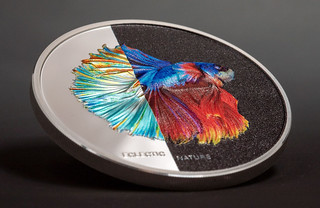 CIT showcases the unique beauty of the Siamese fighting fish with precise color printing and
smartminting® technology on a commemorative coin that is just as unique as the fish itself. The
different features of the creature are represented by the different finishes of the field: shiny proof on
one side, silk black finish on the other. Just like yin and yang, the different characteristics of the
Siamese fighting fish come together to form one creature of exceptional beauty, and this is playfully
picked up by this commemorative coin.
CIT showcases the unique beauty of the Siamese fighting fish with precise color printing and
smartminting® technology on a commemorative coin that is just as unique as the fish itself. The
different features of the creature are represented by the different finishes of the field: shiny proof on
one side, silk black finish on the other. Just like yin and yang, the different characteristics of the
Siamese fighting fish come together to form one creature of exceptional beauty, and this is playfully
picked up by this commemorative coin.
For more information, or to order, see:
https://www.cit.li/coins/eclectic-nature-fighting-fish/
Eclectic Nature – Fighting Fish
(https://www.youtube.com/watch?v=l5NOvfTPtSQ)
1937 MANILA EUCHARISTIC CONFERENCE MEDALS
Earl Honeycutt and Sandy Lichauco submitted this article on the 1937 Manila Eucharistic Conference medals. Thanks! -Editor
1937 Manila Eucharistic Conference Medals
Earl Honeycutt and Sandy Lichauco
Against the backdrop of the rise of communism in the world and 56 years after the first Eucharistic Congress held in Lille, France, the 33rd International Eucharistic Congress took place in Manila, Philippines, from February 3-7, 1937 with great significance. The Congress was notable as it was the first Eucharistic gathering in the Philippines and more importantly, in Asia. The event was attended by 1.5 million from around the world, and events were held in Rizal Park, with hundreds of thousands present at each gathering. It will also be remembered as having the largest religious procession of more than 600,000 Catholic devotees. At that time, it was considered the largest gathering held in what remains the only predominantly Catholic country in Asia. To memorialize this event, two medals were minted and presented/sold to attendees. This article seeks to highlight these medals as it coincides this year with the 500th anniversary of Christianity in the Philippines:
The initial, and most frequently encountered medal is the Honeycutt 284:
284
O: Congressus/ Eucharisticus/ Internationalis/
Manilanus/ 1937/ Vatican Scene
R: Evangelium/ Omni/ Creaturae/ Praedicate/ 1521
Worship Scene: Cross at Center, With Palm Trees,
Sea, & Mountains in Background
40 x 40 mm With Loop
The design on the obverse of the medal has the symbol of the Eucharist shining above the church to commemorate the Congress as a gathering of the clergy and the faithful to glorify Our Lord in the Blessed Eucharist. With the words Congressus, Eucharisticus, Internationalis and Manilanus translated from Latin as the International Eucharistic Congress (Manila). While the reverse of the medal has the scene of the very first mass in the Philippines held 500 years ago.
Recent research by the authors has documented seven metal varieties in aluminum, brass, bronze, gold, white metal, sterling silver, and silver plate. The sterling silver variety is stamped "sterling" on the medal's bottom edge. All medals were minted by Crispulo Zamora, one of the most well-known Manila medal makers in the Philippines. Sources also state that Zamora produced 100 sets of gold medals with matching stamps. To date, few gold medals examples are known to exist, which makes the gold variant the rarest amongst the different metal varieties of the medal, maybe even considered rarer than hen's teeth.
The bronze variant is the next hardest to find amongst the H-284 metal variants.
Likewise, the medals were also differentiated by their pin bars which were silver, silver plate, or bronze, and read: XXXIII Eucharistic Congress/ Manila and had different designs. The authors are in possession or have pictures of multiple varieties of ribbons and pin bars.
The second Eucharistic Congress medal is similar to H-284 discussed above, but it features Pope Pius XI and is listed as Honeycutt 284-1. The medal was produced in silvered and bronze versions and is slightly smaller in size (30 x 30 mm).
284-1
O: Congressus/ Eucharistic/ Internationalis/
Manilanus/ 1937/ Pope Pius XI Bust
R: Evangelium/ Omni/ Creaturae/ Praedicate/ 1521
Worship Scene: Cross at Center, With Palm Trees,
Sea, & Mountains in Background
30 x 30 mm Silvered With Loop
284-1a Similar, but Bronze
284-1b Similar, but Silvered with Red Obverse
Interestingly, this fairly-common and distributed medal was unlisted in both Basso books, but it is increasingly popular and brings record prices in sterling silver, bronze, and the ever-elusive gold variety! Pristine medals that include pin bars and ribbons are highly sought after and sell for premium prices. It has become a challenge for both authors to gather and collect all variants of these medals, especially the elusive Gold variant.
AMERICA'S FIRST SHOPPING MALL ON PAPER MONEY
The New England Numismatic Association's official publication is NENA News. John Ferreri offered to share some articles with E-Sylum readers. Last week we republished John's own article on the Elm City Bank of New Haven. Here's another one of these, this time on the first shopping mall in America and its appearance on paper money. John kindly provided image files. Thanks! -Editor
America's First Shopping Mall: The Arcade Building, Providence, RI
This new and exciting shopping mall was the center vignette of at least two different Rhode Island State Bank Notes. Circa 1850.
Did your Great-Great-Great-Grandmother shop here? If she lived in the Providence, R.I. area during the mid-1800s and was able to drive her horse and buggy to shop downtown she might have visited this new and exciting type of retail business place, a mall! The Westminster Arcade Building was built in 1828, primarily of granite and housed three levels of mercantile businesses. The building helped revitalize a neglected part of downtown Providence during the mid-1800s. The building has endured close to two centuries of use, many internal renovations and is still in use, today. Great Granny could have shopped here for millinery goods, fresh foods, East India goods and perhaps furniture. The Arcade Bank opened in this building in 1831 and remained here until it became a national bank in 1865. Great-Great-Great Granny could easily have spent money issued by this bank. It would be decades before federally issued paper money replaced the issues of state chartered banks.
This image of the $3 note of the Arcade Bank shows the Westminster Street entrance to the Arcade building which was designed by James C. Bucklin. The note lacks signatures because it is a proof impression struck for inspection by the bank board of directors and not meant for issue.
The building was built between Westminster and Weybosset Streets and after trying to decide which architectural rendering to choose for the two entrances it was decided to use both, one at the Westminster Street entrance and the other at the Weybosset Street entrance.
The Weybosset Street entrance was designed by Russell W. Warren and while obviously different, is still in keeping with Greek Revival Architecture. Thanks to this bank and many others, scenes of local structures and neighborhoods have been preserved on the issues of their paper currency.
This modern image of the Arcade Building after its latest renovation shows a mall with retail businesses on the ground floor and micro-apartment space on the two upper floors. This type of apartment has become popular for people wanting to live in downtown areas with a minimum of floor space. This building has now been operating for almost 200 years without major exterior renovation.
John adds:
"This story brings back memories. When I was in college I often took the train from Boston to Providence where I connected with a bus to my home town of Willimantic, Connecticut. The Arcade building was a short walk from both the bus and train station. I recall that the area with the Arcade was somewhat derelict, and much like the Faneuil Hall / Quincy Market area in Boston. Both areas have been cleaned up now and are popular tourist spots!"
For more information on the New England Numismatic Association, see:
https://www.nenacoin.org/
To read the earlier E-Sylum article, see:
THE ELM CITY BANK OF NEW HAVEN
(https://www.coinbooks.org/v24/esylum_v24n40a23.html)
LOOSE CHANGE: OCTOBER 10, 2021
Here are some additional items in the media this week that may be of interest. -Editor
On CoinWeek. Louis Golino examines the impact of the tenure of U.S. Mint Director David Ryder. See the complete article online. -Editor
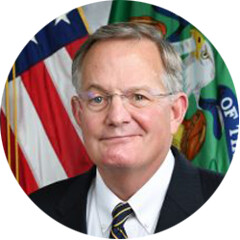 In the aftermath of the resignation October 1 of David J. Ryder as Director of the United States Mint, which was announced late on Friday, September 24, comments from many collectors in online forums and letters to editors of coin publications have been strongly critical of Ryder's tenure.
In the aftermath of the resignation October 1 of David J. Ryder as Director of the United States Mint, which was announced late on Friday, September 24, comments from many collectors in online forums and letters to editors of coin publications have been strongly critical of Ryder's tenure.
The popular sport of Mint bashing had become more popular than usual over the past couple of years, which makes this a good time to take a step back from knee-jerk reactions–mostly driven by collectors who couldn't order all the coins they wanted from the Mint–and assess what actually happened during the three years Ryder was in charge at the Mint and what his longer-term impact may be on the hobby.
To read the complete article, see:
The Coin Analyst: What Will Mint Director Ryder's Long-Term Impact Be on the Numismatic Hobby?
(https://coinweek.com/modern-coins/the-coin-analyst-what-will-mint-director-ryders-long-term-impact-be-on-the-numismatic-hobby/)
This Washington Post article discusses a coin found at a dig in Williamsburg. -Editor
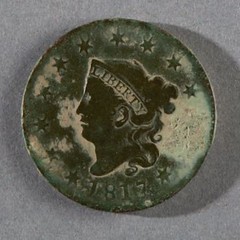 In the early 1800s when enslaved and free African Americans wore their Sunday best to the Baptist Meeting House in Williamsburg, Va., the straight pins used to fasten women's clothing would sometimes come loose and fall to the floor.
In the early 1800s when enslaved and free African Americans wore their Sunday best to the Baptist Meeting House in Williamsburg, Va., the straight pins used to fasten women's clothing would sometimes come loose and fall to the floor.
Later, when the church was cleaned, the pins would be swept outside, and over time they would accumulate in the dirt by the entrance.
Archaeologists have now found 50 of them outside a probable doorway to the long-vanished church on Nassau Street, and they believe the pins are clues to the lives of the Black people who worshiped there 200 years ago.
Colonial Williamsburg announced Thursday that its experts have also found an 1817 penny at the site, as well as another grave.
To read the complete article, see:
An old coin, a pile of straight pins offer clues to bygone life of African American church
(https://www.washingtonpost.com/history/2021/10/06/williamsburg-dig-black-church-artifacts/)
Here's an interesting numismatic connection (of sorts) to the classic story of Jekyll and Hyde. Found via News & Notes from the Society of Paper Money Collectors (Volume VII, Number 16, October 5, 2021) -Editor
Whilst it's almost certain most people would know of the term Jekyll and Hyde as a term used to describe someone who can change personalities be it induced by drugs, alcohol, medical or a mental disorder or as in the story by a man made potion. The origins of the characters and why the author chose these names is probably not known at all; we move to shine a light on this and the twist that involves banknotes.
To read the complete article, see:
Jekyll and Hyde - The Banknote Connection
A strange tale indeed..............
(https://banknoteindex.com/articles/India_Hyde/India_Hyde.mhtml)

